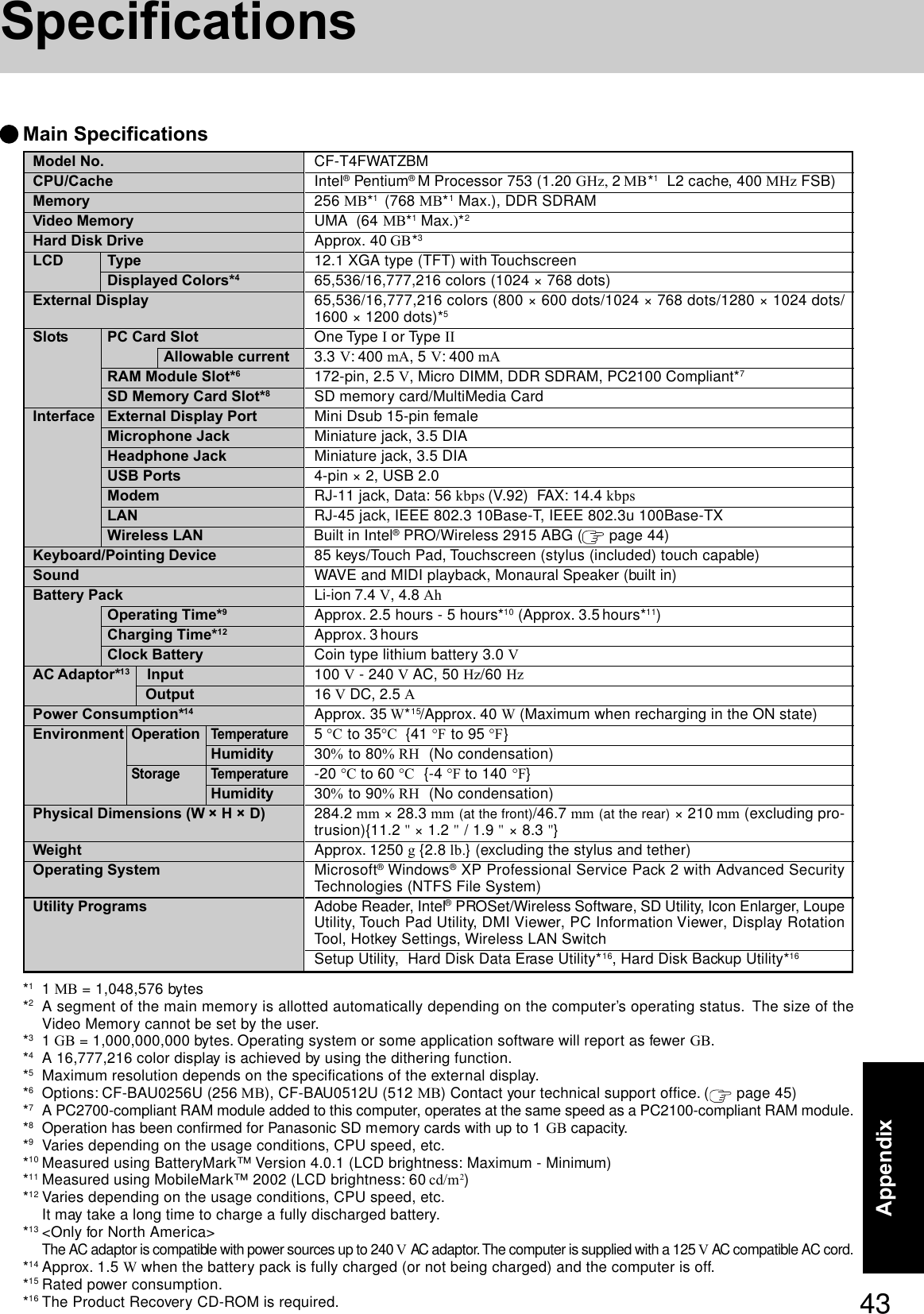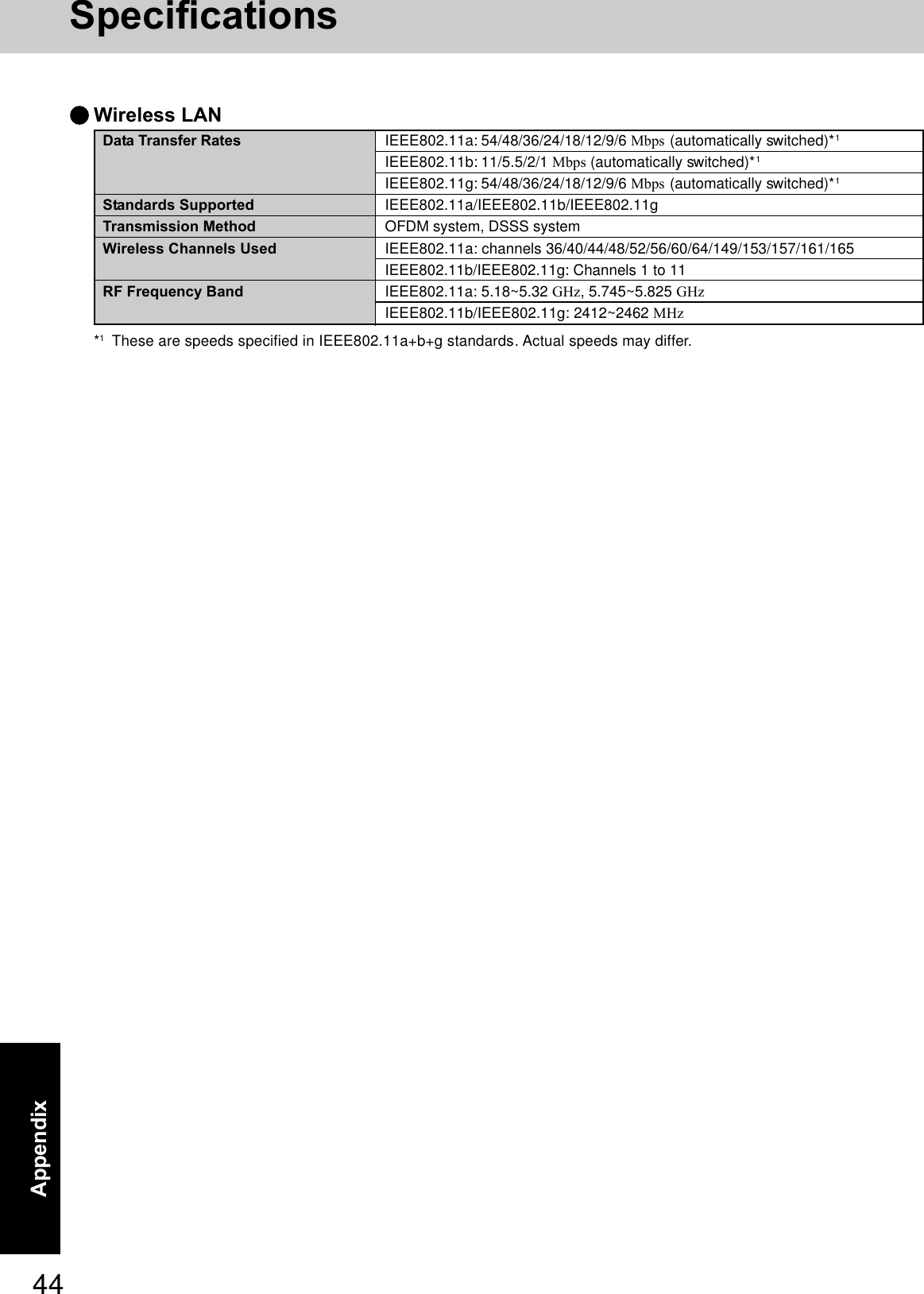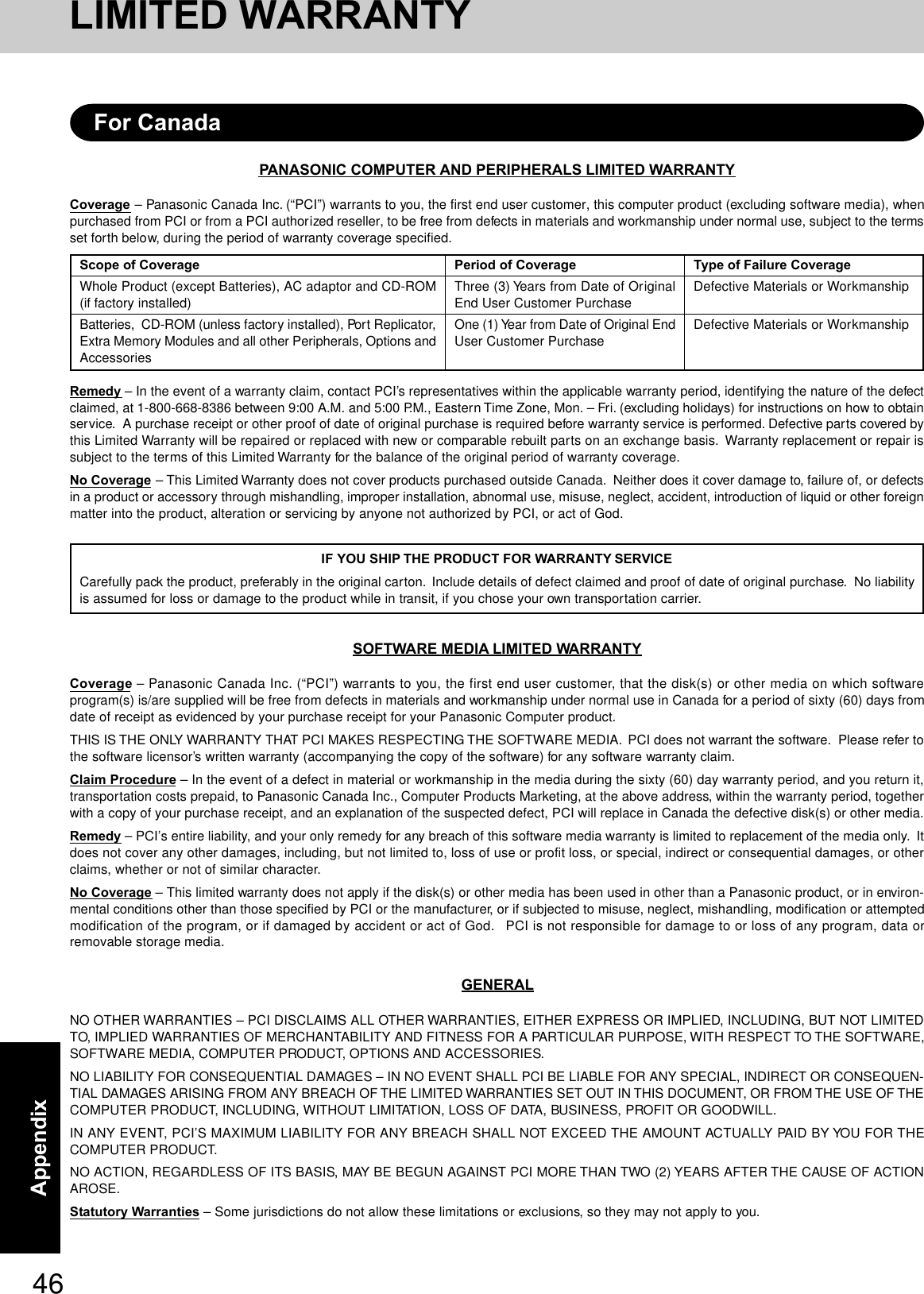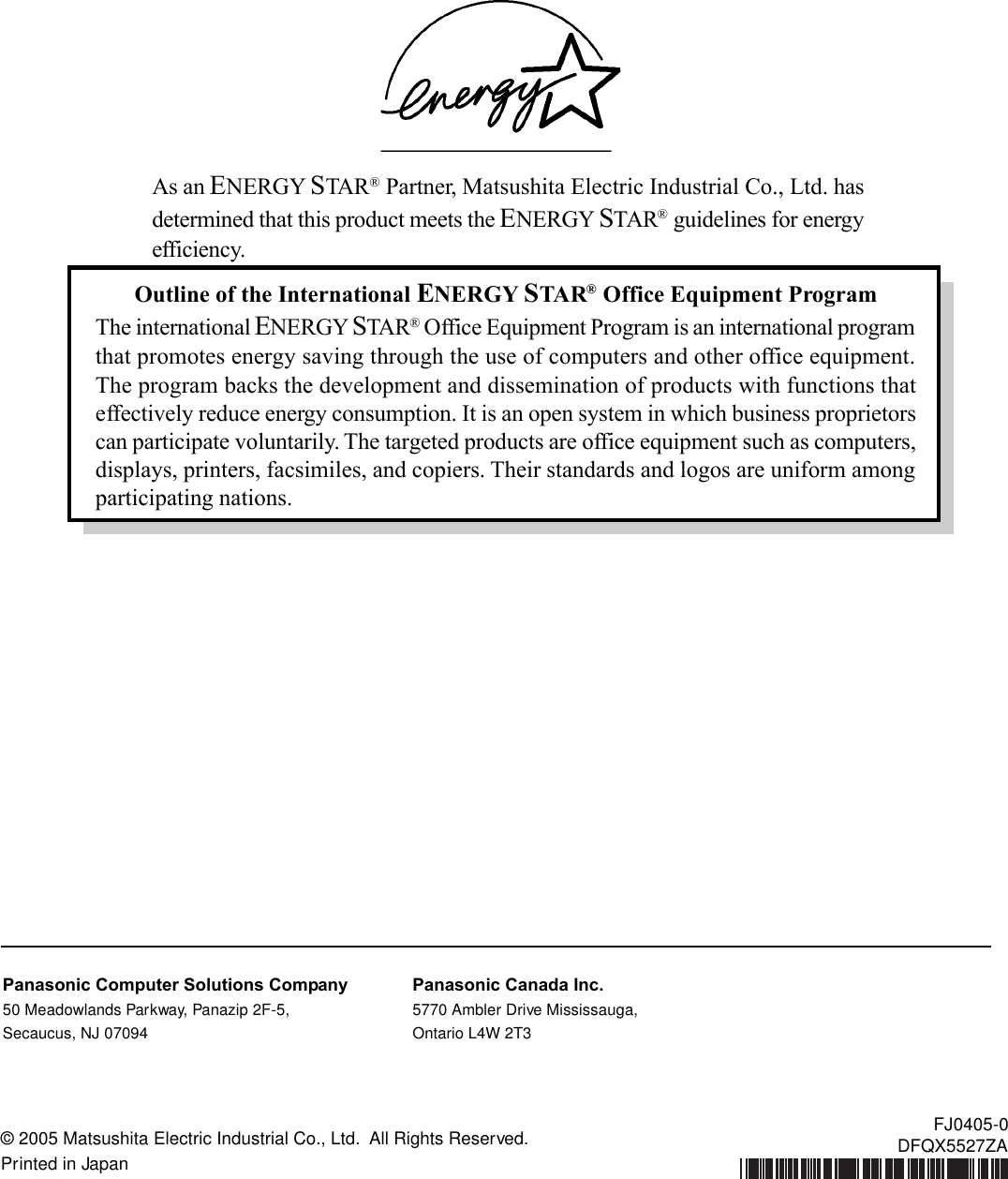Panasonic of North America 9TGCF-T41 Personal Computer CF-T4 Series User Manual OPERATING INSTRUCTIONS
Panasonic Corporation of North America Personal Computer CF-T4 Series OPERATING INSTRUCTIONS
Contents
- 1. PC User Manual
- 2. WLAN User Manual
PC User Manual
![Personal ComputerOPERATING INSTRUCTIONSAppendixLIMITED USE LICENSE AGREEMENT ....... 36Hard Disk Backup Function........................... 38Hard Disk Data Erase Utility.......................... 42Specifications ................................................ 43LIMITED WARRANTY................................... 45TroubleshootingList of Error Codes ......................................... 28Dealing with Problems (Summary)................... 29Reinstalling Software .................................... 34OperationStarting Up/Shutting Down............................ 16Touch Pad ..................................................... 19Reference Manual.........................................20RAM Module ................................................. 21Useful Information .........................................24Getting StartedRead Me First ................................................. 3Names and Functions of Parts........................ 8First-time Operation ......................................12Contents[Additional Manual]Reference ManualThis manual can be accessed on your computer. Re-fer to page 20 on how to access the Reference Manual.Appendix Getting StartedOperationTroubleshootingPlease read these instructions carefully before using this product and save this manual for future use.XPModel No. CF-T4 SeriesPage](https://usermanual.wiki/Panasonic-of-North-America/9TGCF-T41.PC-User-Manual/User-Guide-566641-Page-1.png)
![2Getting StartedIntroductionThank you for purchasing the Panasonic computer. Read the operating instructions thoroughly for proper operation of your newcomputer.Illustrations and Terminology in this ManualCopyrightThis manual is copyrighted by Matsushita Electric Industrial Co., Ltd. with all rights reserved. No part of this manual may bereproduced in any form without the prior written permission of Matsushita Electric Industrial Co., Ltd.No patent liability is assumed with respect to the use of the information contained herein.© 2005 Matsushita Electric Industrial Co., Ltd. All Rights Reserved.DisclaimerComputer specifications and manuals are subject to change without notice. Matsushita Electric Industrial Co., Ltd. assumes noliability for damage incurred directly or indirectly from errors, omissions or discrepancies between the computer and the manuals.TrademarksMicrosoft, Windows and the Windows logo are registered trademarks of Microsoft Corporation of the United States and/or othercountries.Intel, Pentium and PROSet are either registered trademarks or trademarks of Intel Corporation.SD Logo is a trademark.Adobe, the Adobe logo and Adobe Reader are either registered trademarks or trademarks of Adobe Systems Incorporated in theUnited States and/or other countries.Panasonic is a registered trademark of Matsushita Electric Industrial Co., Ltd.Names of products, brands, etc., appearing in this manual are trademarks or registered trademarks of their respective ownercompanies.NOTE:NOTE provides a useful fact or helpful information.CAUTION:CAUTION indicates a condition that may result in minor or moderate injury.Enter : This illustration means to press the [Enter] key.Fn + F5 : This illustration means to press and hold the [Fn] key, then press the [F5] key.When using with the [Fn] and [Ctrl] functions interchanged, read with [Fn] and [Ctrl] reversed ( “Using the Fn Key”).[start] - [Run]: This illustration means to click [start], then to click [Run]. :Where to go for referred information. : This illustration means to refer to the Reference Manual, which is available on your computer.Refer to page 20 on how to access this manual.Some of the illustrations in this manual may differ slightly in shape from the actual items in order to make the explanationeasier to understand.In this manual, “Microsoft® Windows® XP Professional Service Pack 2 with Advanced Security Technologies” is indi-cated as “Windows” or “Windows XP”.If the user has logged on without the administrator authority, some functions may not be executable, and some screens maynot be displayed as shown in this manual. If this happens, log on with the administrator authority to enable these functions.Confirm the latest information on optional products in catalogs, etc.Customer’s RecordSerial No.orDate of PurchaseModel No. *1Code No.Dealer’s NameDealer’s Address*1For the Model No., insert the 12 digit number (for example, CF-T4FWATZBM) located onthe bottom of the computer.](https://usermanual.wiki/Panasonic-of-North-America/9TGCF-T41.PC-User-Manual/User-Guide-566641-Page-2.png)
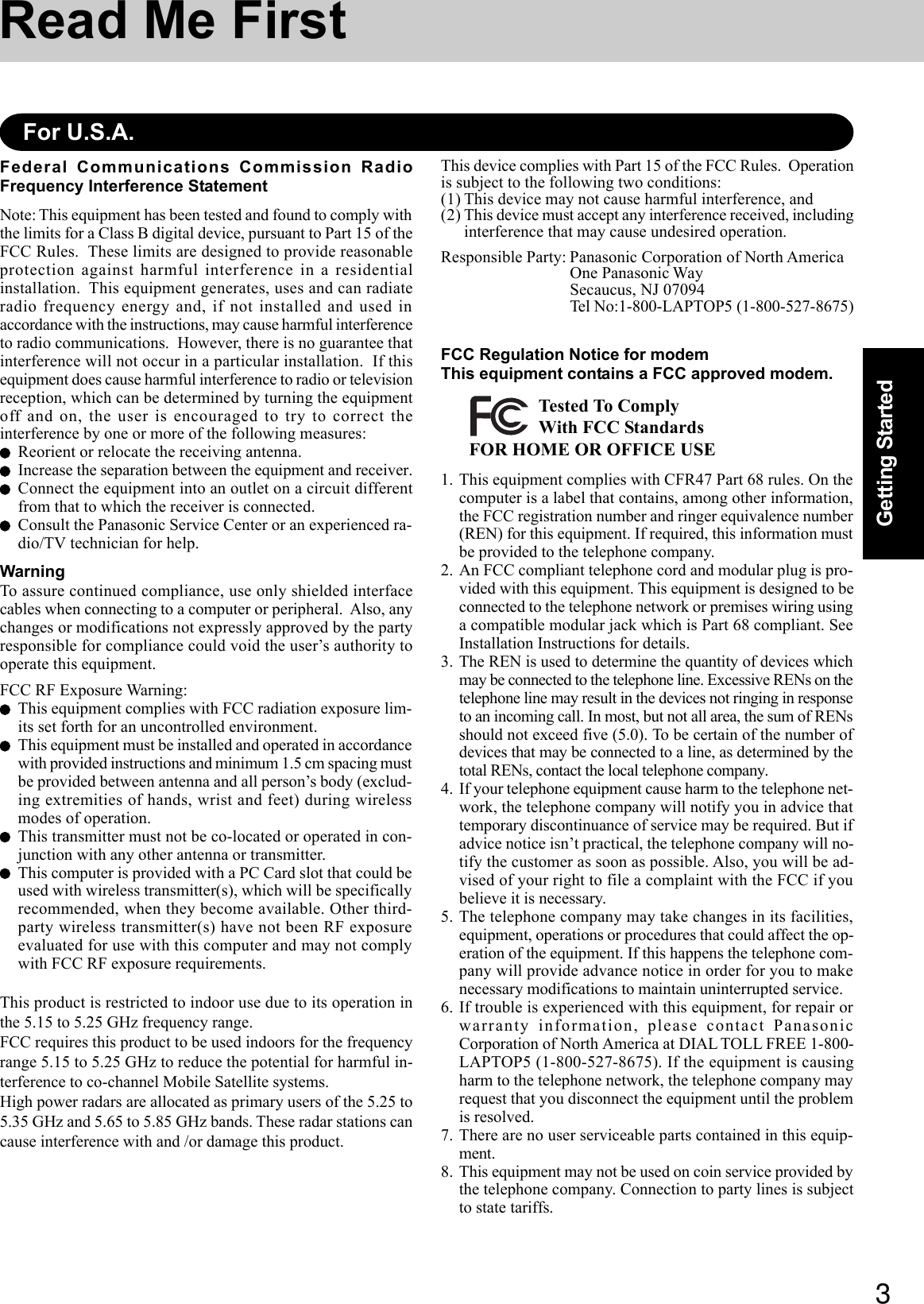
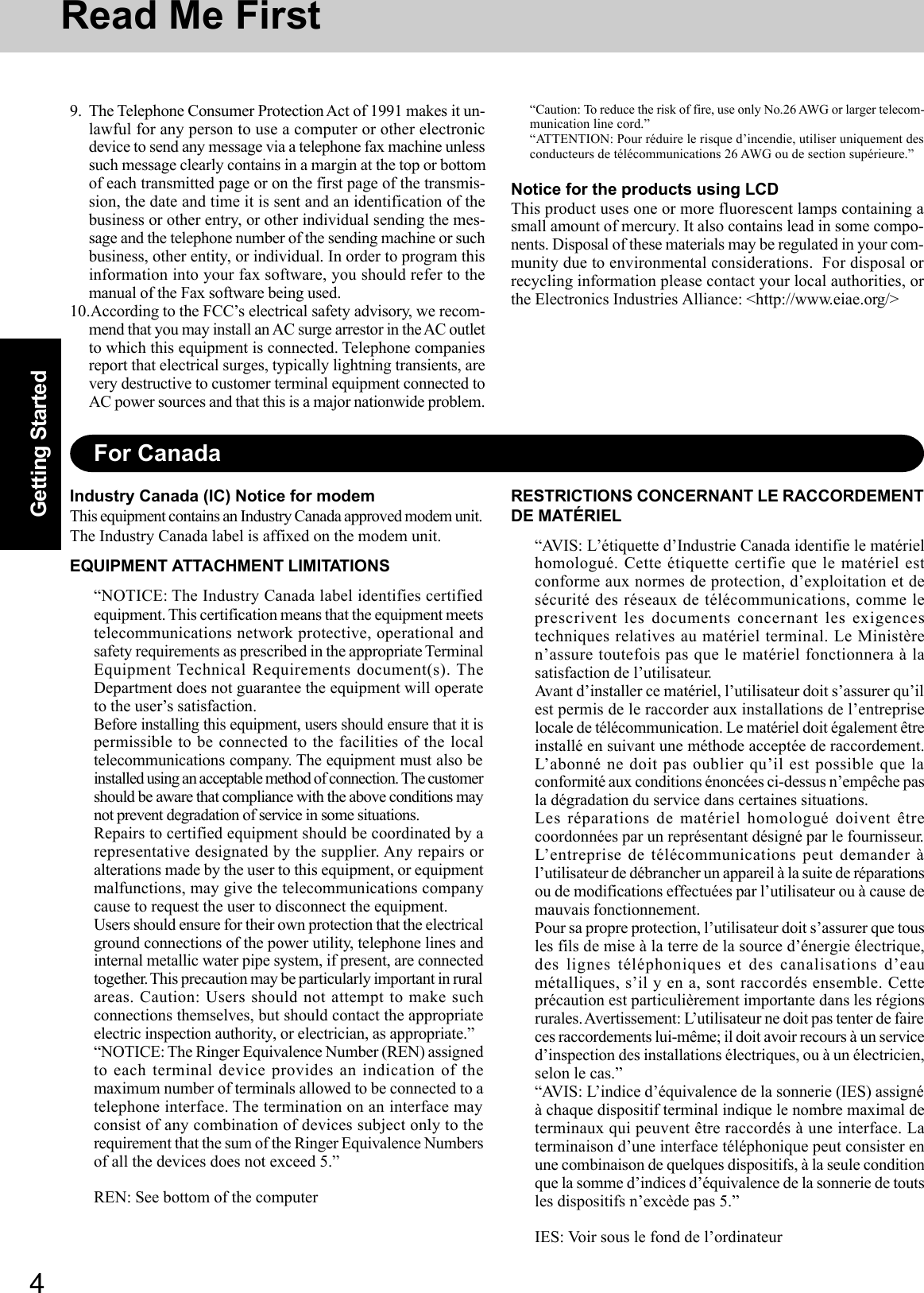
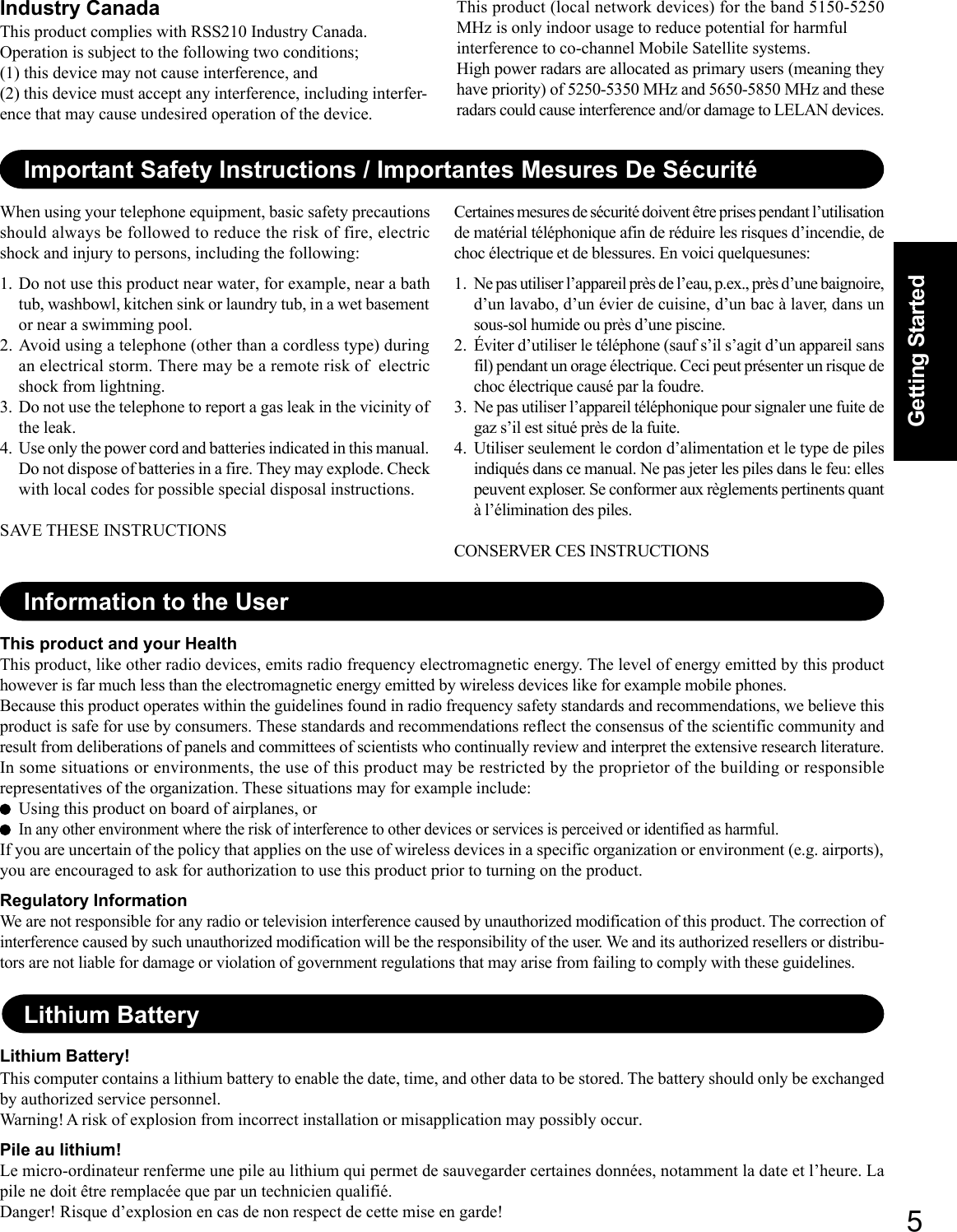
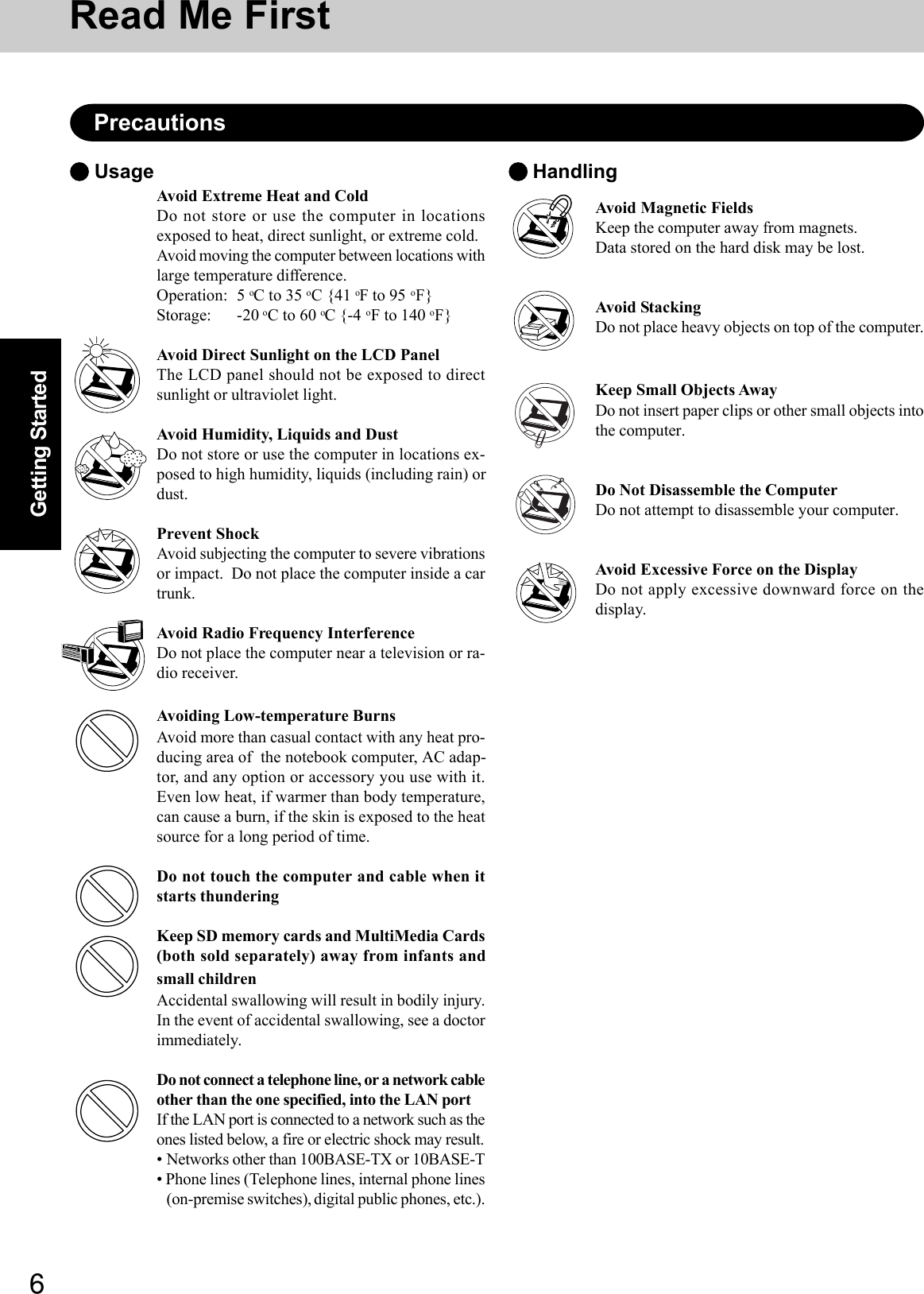
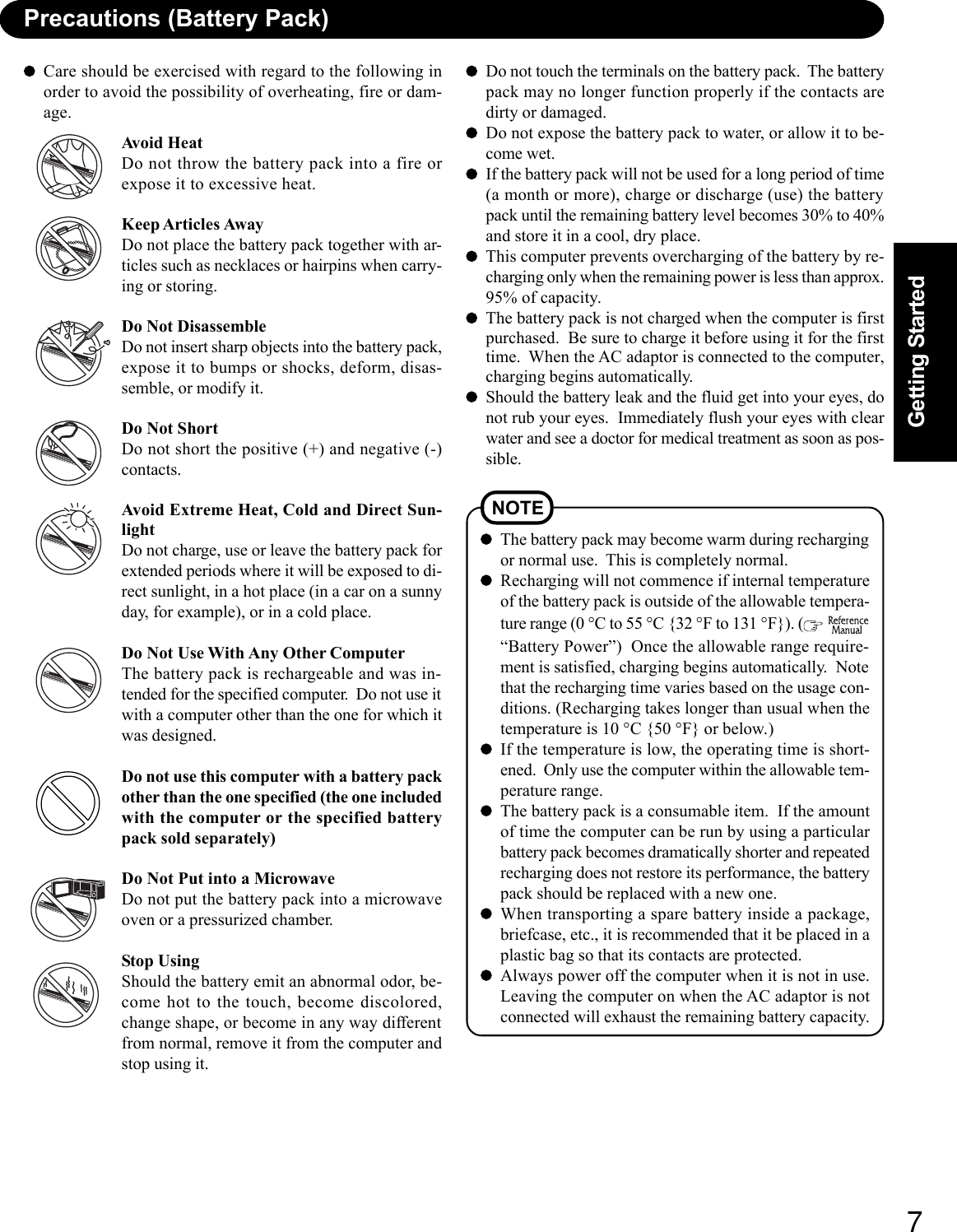
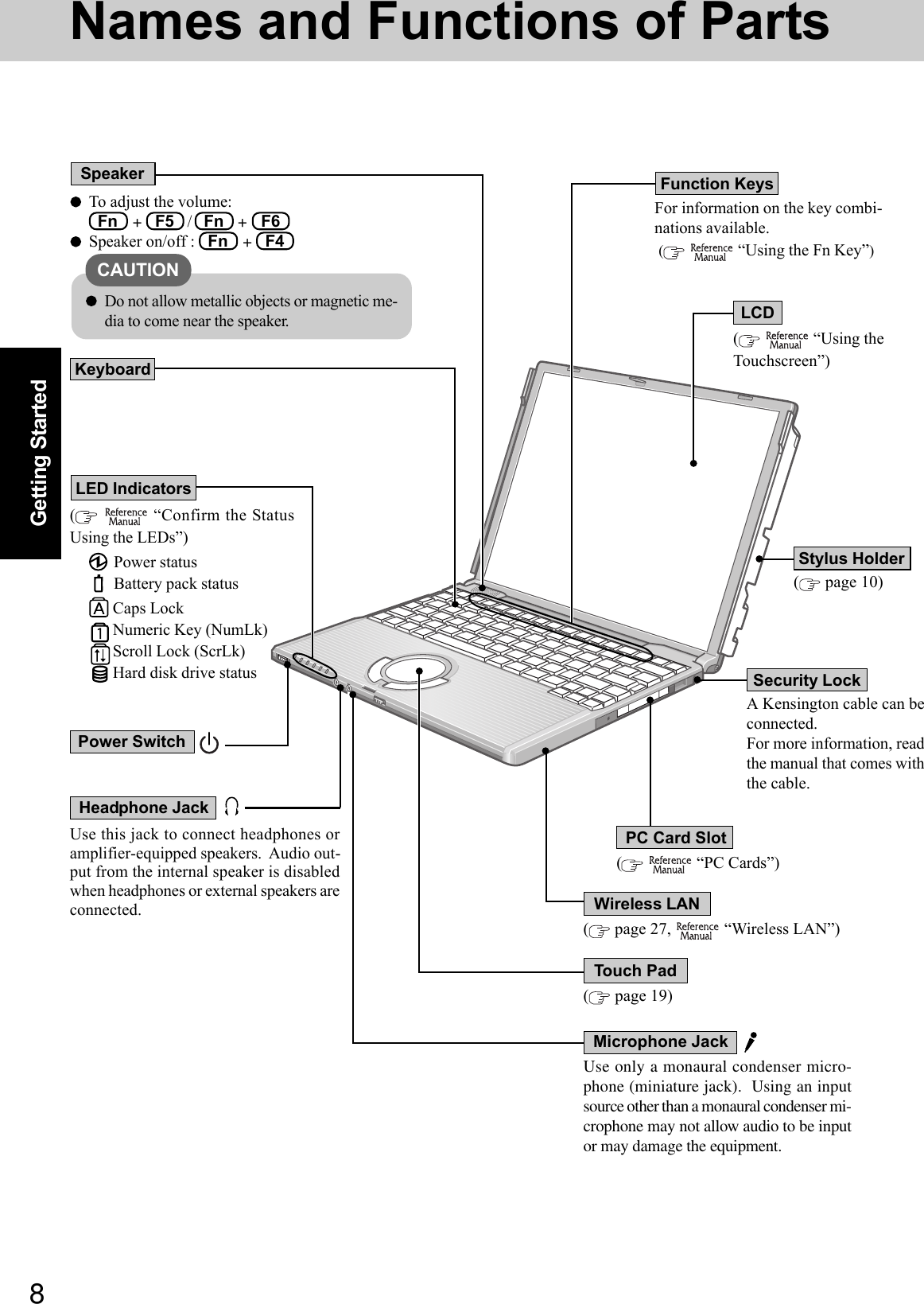

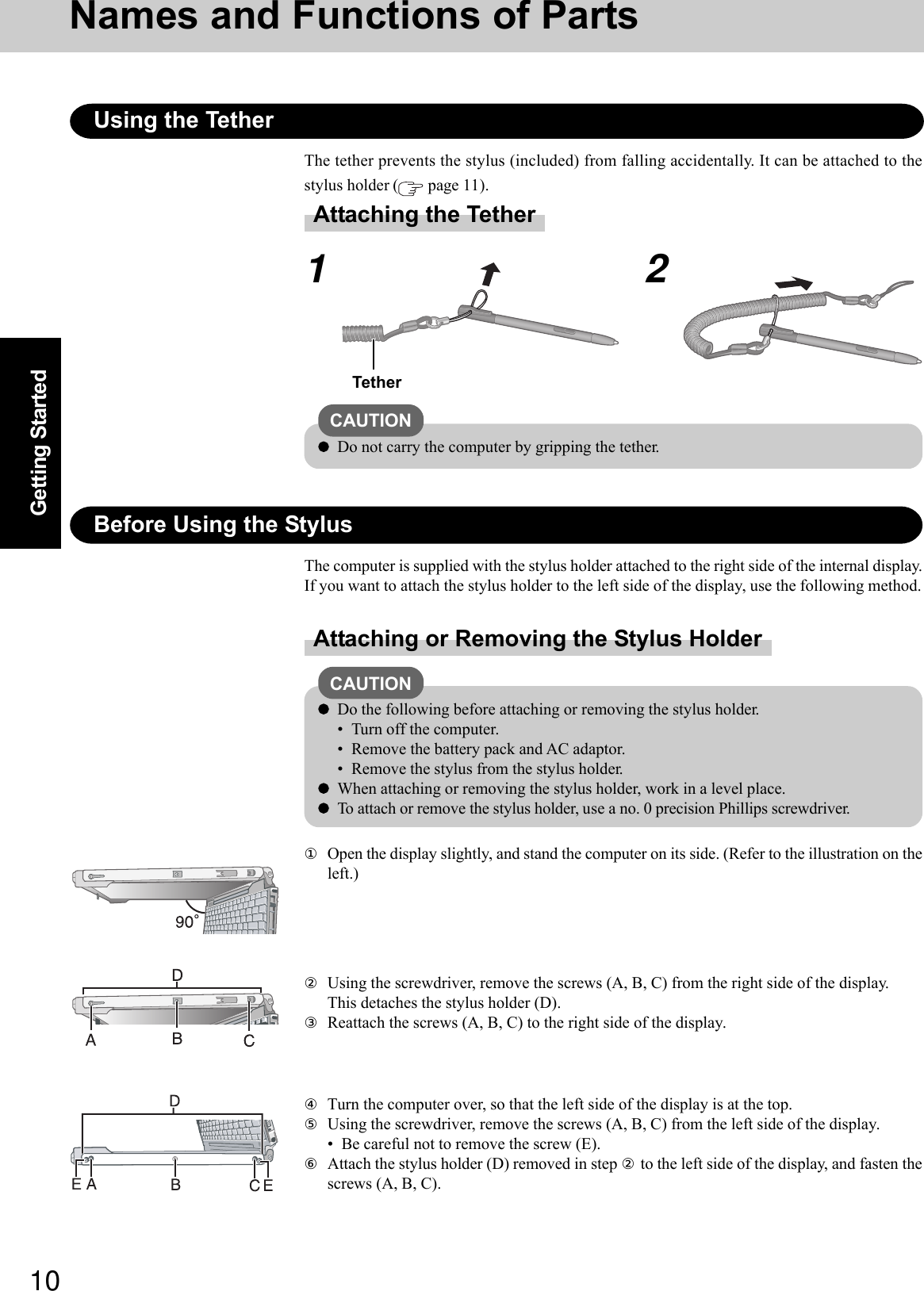
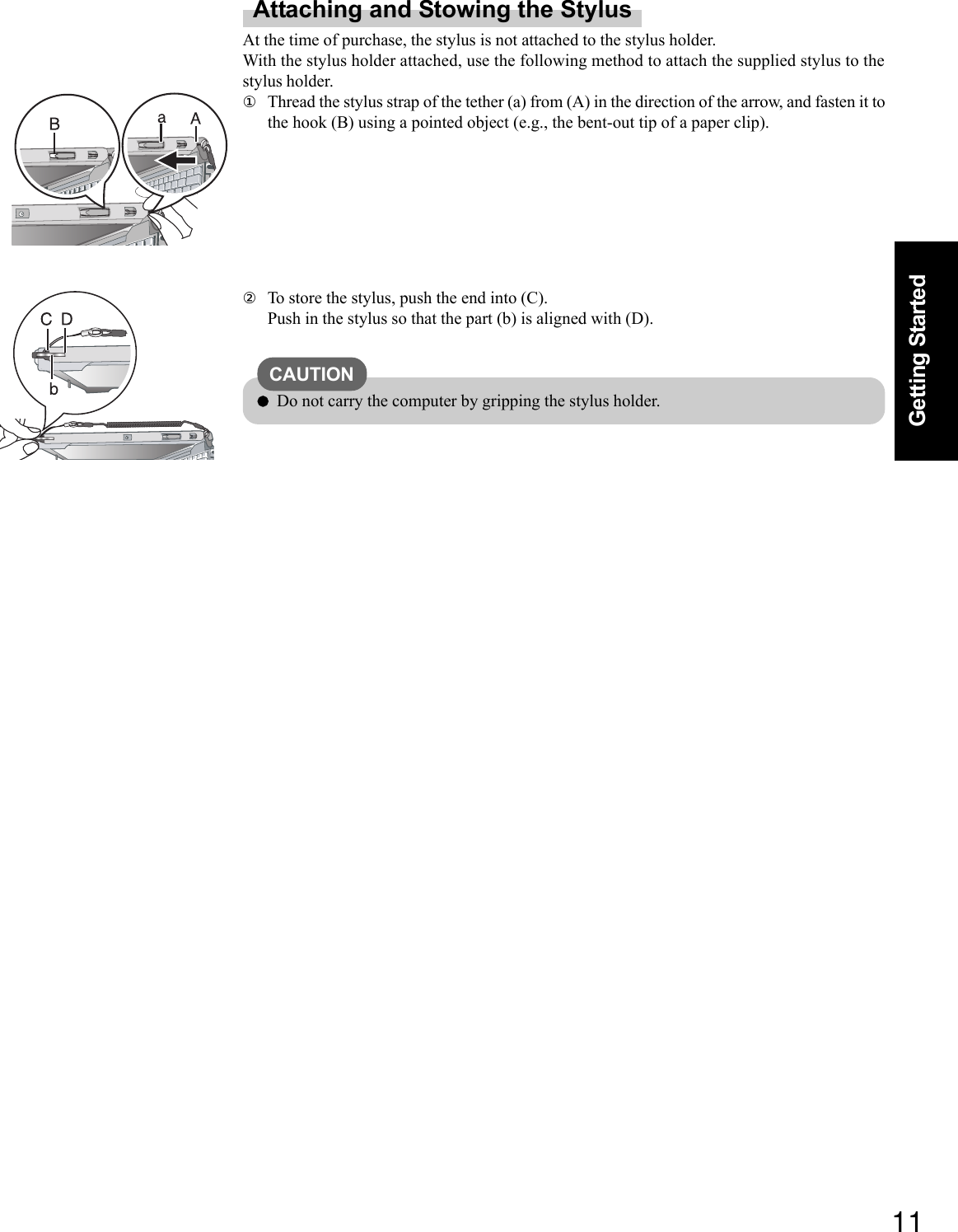

![13Getting StartedConnect your computer to a power outlet.CAUTIONBe sure the AC adaptor is connected until completing the first-time use opera-tion.When using the computer for the first time, do not connect any peripheral de-vice except the battery pack and AC adaptor to the computer.Handling the AC adaptorDo not twist or pull the AC power cord forcefully. Doing so may damage theconnections.Use only the specified AC adaptor with your computer. Using an AC adaptorother than the one supplied might damage the battery and/or the computer.When the DC plug is not connected to the computer, disconnect the AC cordfrom your AC wall outlet.Problems such as sudden voltage drops may arise during periods of thunder andlightning. Since this could adversely affect your computer, an uninterruptiblepower source (UPS) is highly recommended unless running from the batterypack alone.5CAUTION6Turn your computer on.Slide the power switch and hold it for approximately one second until the powerindicator turns on before releasing it.Do not slide the power switch and hold it for more than four seconds; this willcause the power to be turned off forcibly.Do not slide the power switch repeatedly.Once the computer is powered off, you must wait at least ten seconds beforepowering it on again.7Setup Windows.Moving the cursor or clicking buttons can be performed with the touch pad( page 19).The battery pack will be charged automatically.Charging Time: Approx. 3 hours(Varies depending on the usage conditions.)Do not press any keys, or touch the touch pad or touchscreen until [WindowsXP Professional Setup] is displayed.CAUTION1At [Welcome to the Windows XP Setup Wizard], click [Next].2After reading the agreement, click [I accept this agreement] or [I don’t accept thisagreement], then click [Next].NOTEIf [I don’t accept this agreement] is selected, the Windows setup will beaborted.3Select settings for your region, then click [Next].4Enter your name and organization and then click [Next].](https://usermanual.wiki/Panasonic-of-North-America/9TGCF-T41.PC-User-Manual/User-Guide-566641-Page-13.png)
![14Getting StartedFirst-time Operation6Set the correct date, time and the time zone, then click [Next].CAUTIONRemember this password! If the password is forgotten, Windows cannot beoperated.7Enter your administrator password and click .5Enter your computer name and administrator password and then click [Next].NOTEIt may take some time before the computer restarts and the screen of step 7is displayed. Wait, and do not press any keys, or touch the touch pad ortouchscreen, etc.If the keyboard or the touch pad etc. are operated, a message will appearindicating that there is no response on the screen, or some screens mayappear white. In such cases, also wait until the next screen is displayed.CAUTIONRemember this password! If the password is forgotten, Windows cannot beoperated. You can create a password reset disk beforehand ( page 15).8Create a new account.1Click [start] - [Control Panel] - [User Accounts] - [Create a new account].2Enter a new name for the new account, then click [Next].3Select [Computer administrator], then click [Create Account].4<When you want to create a password for the new account>Select the new account you have created and click [Create a password].Follow the instructions on the screen to create a password.5Click [start] - [Turn Off Computer] - [Restart] to restart the computer.When Windows setup is completed, the following message will be displayedat the bottom right of the screen: “Your computer might be at risk.” Con-tinue to the next step.The message is generated by the [Security Center] function in [ControlPanel], and does not indicate an error or malfunction. For more informationabout [Security Center]: page 26NOTEThe computer will restart.](https://usermanual.wiki/Panasonic-of-North-America/9TGCF-T41.PC-User-Manual/User-Guide-566641-Page-14.png)
![15Getting StartedDepending on the Windows settings, installed applications, and drivers, menus andother displays may differ, or some functions (such as use of the password reset disk)may be inoperable. Check with your system administrator for details.You can select Classic view for the Control Panel or select the Classic Start menu.You can also change the way a user logs on or off.The procedure in this manual uses the method or view of the Windows XP defaultsetting (not Classic view nor Classic Start menu etc.).Resetting the passwordWindows XP has a function to reset a forgotten password.To use this function, you need to create a password reset disk beforehand followingthe steps below.1Connect the USB floppy disk drive (optional: CF-VFDU03) to your computer.2Click [start] - [Control Panel] - [User Accounts].3Click [Prevent a forgotten password] from [Related Tasks] menu of the accountyou used to logon and create a password reset disk following the on-screen instruc-tions.Store the password reset disk in a safe place.·Only the logon password for each account can be reset.The password set in the Setup Utility cannot be reset.Information for Windows XPThis concludes the first-time use operation guidelines.When creating a new user account:· If you make mail settings, create password reset disks ( below), orconduct other related operations before creating the user account, you willbe unable to use any previous mail history or settings.· When you create the first new account, you can only select [Computeradministrator].Once a “Computer Administrator” account has been created, you can cre-ate additional limited user accounts.Note also that only the added user account will be displayed in the Wel-come screen. The account for the administrator created during Windowssetup will not be displayed.The message “Your computer might be at risk,” which is displayed at thebottom right of the screen, is generated by the “Security Center” function inWindows XP, and does not indicate an error or malfunction.To prevent this message from being displayed, refer to “Security of the Com-puter” ( page 26).To improve the security of the computer, be sure to refer to “Security of theComputer” ( page 26) and “Windows Update” ( page 27).About the Icon Enlarger:· If the characters or icons on the screen are too small and difficult to see,after completing step 8, click [start] - [All Programs] - [Panasonic] - [IconEnlarger]. This will allow you to magnify the display of characters andicons on the screen. ( “Icon Enlarger”)· The [Icon Enlarger] can be set separately for each account.You can also use [Loupe Utility], which enlarges a part of the screen. ( “Loupe Utility”)If the cursor can not be pointed correctly with the stylus, perform [Calibra-tion] in [start] - [Control Panel] - [Printers and Other Hardware] - [Mouse] -[TouchScreen].If you use the wireless LAN, be sure to refer to “Wireless LAN” ( page 27).NOTE](https://usermanual.wiki/Panasonic-of-North-America/9TGCF-T41.PC-User-Manual/User-Guide-566641-Page-15.png)

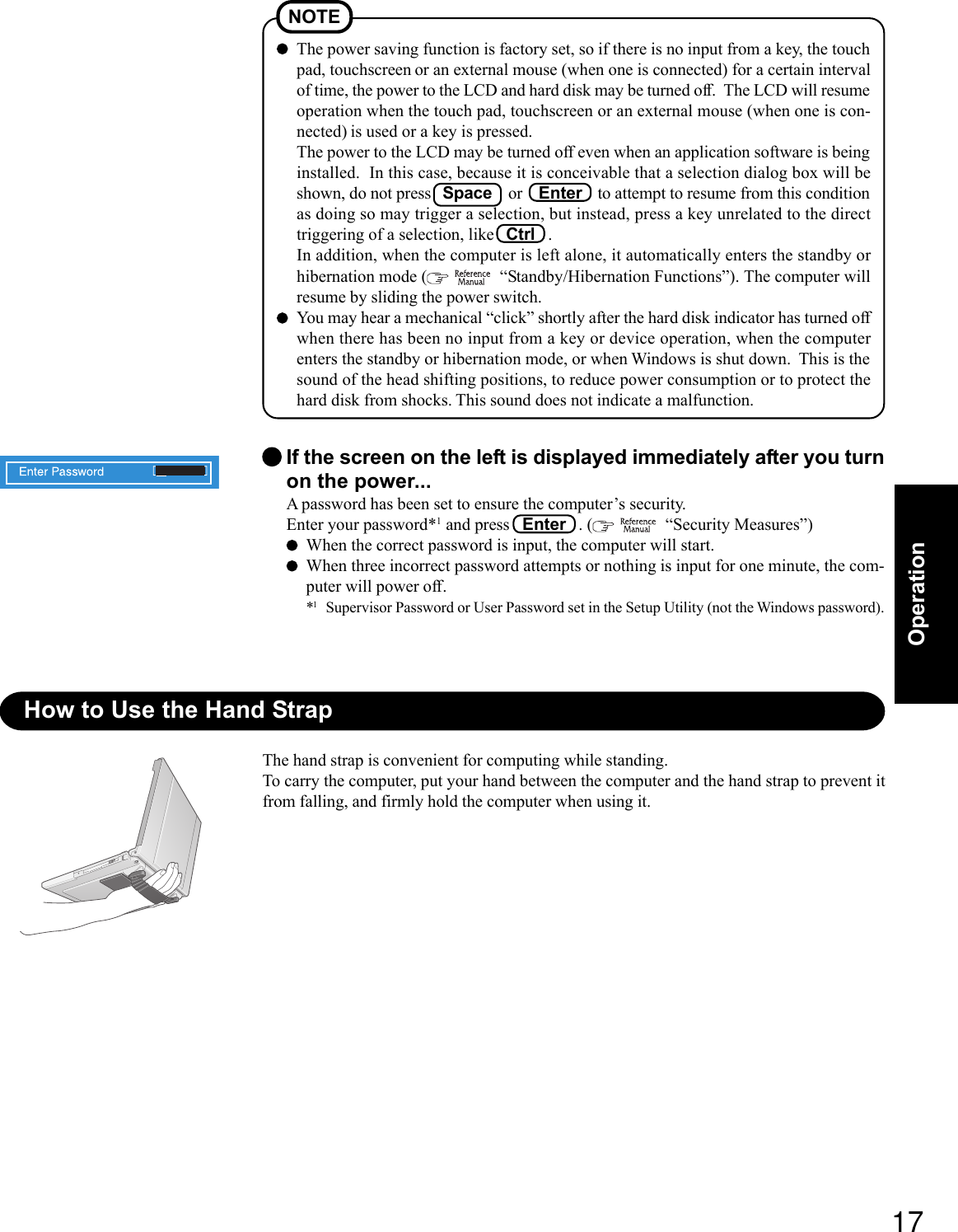
![18OperationShutting Down (power off your computer)1Save important data and close each application.2Click [start] - [Turn Off Computer].3Click [Turn Off].Your computer will power off automatically.Restarting your computer (without shutting down):Click [Restart].To shut down using the keyboard:Press , U , and select [Turn Off] with , then press Enter .CAUTIONDo not do the following during the shutdown/restart procedure.• Connecting or disconnecting the AC adaptor.• Touching the power switch.• Performing any keyboard, touch pad, touchscreen or external mouse operations.• Closing the display.When you leave the computer or interrupt your work...If you use the “Standby” or “Hibernation” function, then when you turn on the power nexttime, the application software and files you were using before will be displayed, and youcan restart the same operations. ( “Standby/Hibernation Functions”)Starting Up/Shutting Down](https://usermanual.wiki/Panasonic-of-North-America/9TGCF-T41.PC-User-Manual/User-Guide-566641-Page-18.png)
![19OperationTouch PadUse the touch pad to move the cursor on the screen and perform computer operations.orFunction OperationMoving the CursorTapping/ClickingDouble-Tapping/Double-ClickingDraggingVertical ScrollHorizontal ScrollMove the tip of your fingerlightly over the work surface.A. Work Surface (Touch Pad)B. Left ButtonC. Right ButtonRefer to [Mouse Properties] for information on basic operations other than the above.To display [Mouse Properties], click [start] - [Control Panel] - [Printers and Other Hard-ware] - [Mouse].When using the touch pad, keep the following in mind.• By design the touch pad is to be used with a finger tip only. Do not place any object onthe work surface or press down forcefully with sharp-pointed objects (e.g., nails) orhard objects that can leave marks (e.g., pencils and ball point pens).• Try to avoid having any harmful substances, such as oil, come in contact with thetouch pad. The cursor may not work properly in such cases.NOTEorTwo quick taps, but on thesecond tap leaving your fin-ger down (applying pres-sure) and moving it on thework surface.While holding down thebutton, moving your fingeron the work surface.Trace a circle around the touch pad.Trace a circle around the touch pad. ( “Using theTouch Pad”)The setup is required before using this function. ( “Using the Touch Pad”)To right-click: Can only be performed by clicking the right but-ton.orortapping clickingdouble-tapping double-clicking](https://usermanual.wiki/Panasonic-of-North-America/9TGCF-T41.PC-User-Manual/User-Guide-566641-Page-19.png)
![20OperationReference ManualThe Reference Manual and the Important Tips can be accessed on your computer. When aprinter is connected, these manuals can also be printed.Illustrations may be difficult to view depending on the magnification. If the illustra-tion is too small, magnify the display.If a printer is connected, we recommend printing the pages required. The illustrationsand display samples may not be printed with a high quality.NOTEReference ManualThe Reference Manual explains functions for you to make greater use of the computer, suchas how to add peripheral devices, how the Setup Utility works, and other useful information.How to access the Reference ManualClick [Reference Manual] in [start].Important TipsImportant Tips provides information on how to maximize use of the battery pack, which isnecessary for computing away from your home or office.It also offers helpful explanations on how to use the touchscreen more effectively.How to access the Important TipsDouble-click on the desktop.Important Tips can also be accessed from [start] - [All Programs] - [Panasonic] - [On-Line Manuals] - [Important Tips].When the Reference Manual or Important Tips is accessed for the first time, the License Agree-ment of the Adobe Reader may be displayed. If it is displayed, after reading the agreement, click[Accept] to access the Reference Manual or Important Tips.Refer to Adobe Reader Help to use the Adobe Reader.Reference Manual / Important TipsContents of theReference Manual](https://usermanual.wiki/Panasonic-of-North-America/9TGCF-T41.PC-User-Manual/User-Guide-566641-Page-20.png)
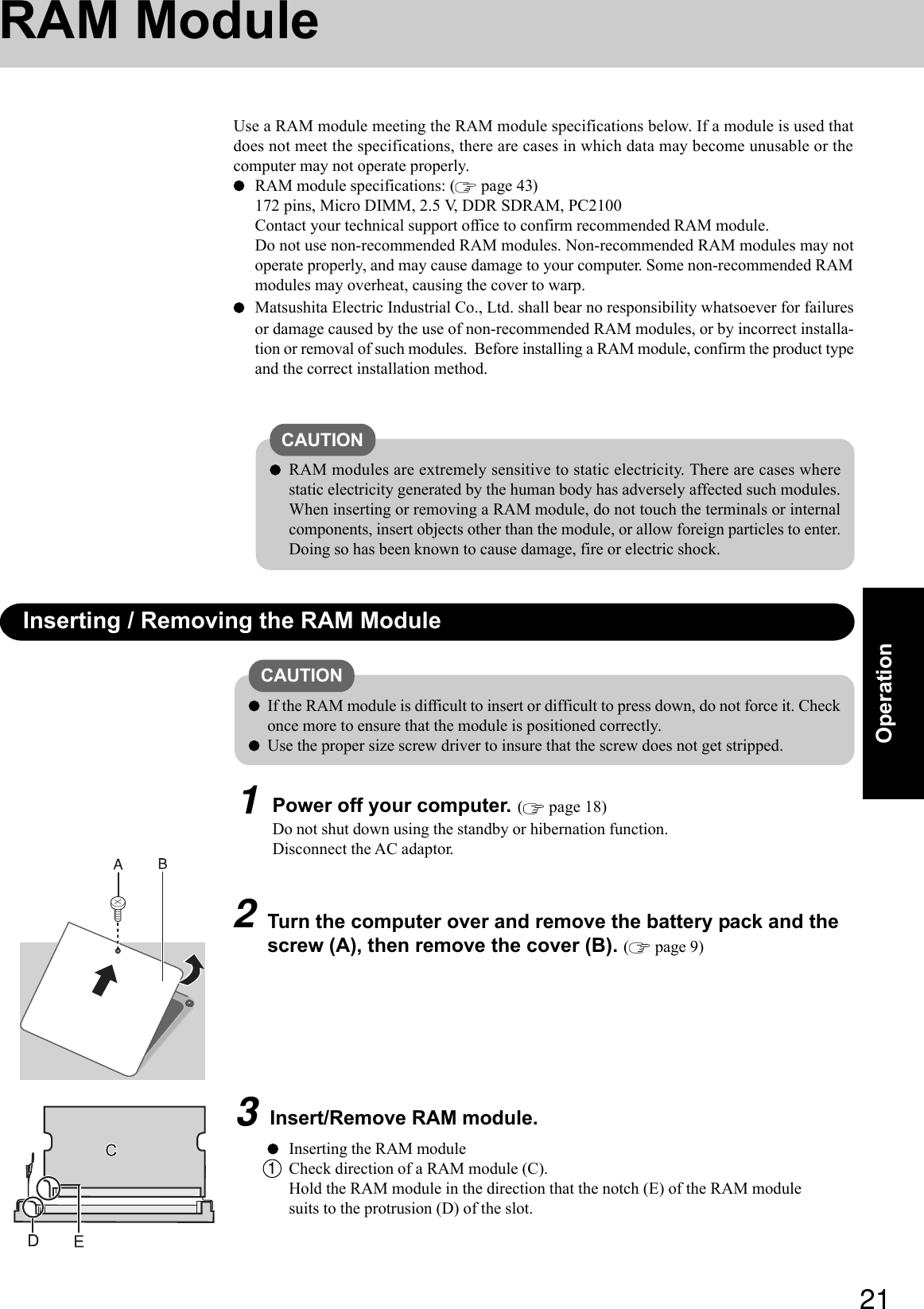

![23OperationRemoving the RAM module1Gently open the left and right hooks (H).The RAM module will be raised at an angle.2Gently remove the RAM module from the slot.4Put the cover back in place.1Insert the cover at an angle, then fit it into place.2Fasten the screw.If the RAM module has not been inserted properly, or if a RAM module other than onematching the specifications has been inserted, a beep will sound and the message “Ex-tended RAM Module Failed” will be displayed when turning the power on. In thiscase, turn the power off, confirm that the RAM module meets the specifications, andreinsert it.Whether the RAM module is properly recognized or not can be confirmed in [Infor-mation] menu of the Setup Utility ( “Setup Utility”).NOTE](https://usermanual.wiki/Panasonic-of-North-America/9TGCF-T41.PC-User-Manual/User-Guide-566641-Page-23.png)

![25OperationWhen Using Peripheral DevicesPay strict attention to the following points to avoid damage to the computer, peripheral devices,cables, etc. Also, in addition to following this manual and the Reference Manual, carefully readthe instruction manuals for the peripheral devices being used.Use only peripheral devices that conform to the computer’s specifications.Connect the devices properly, paying close attention to the condition and position of theconnectors.If a connection cannot be made easily, do not apply undue force; check once more to confirmthe condition and position of the connector (alignment of pins, etc.) .If the connector has holding screws, fasten the screws firmly.Do not carry the computer with cables attached, and do not pull on the cables forcefully.Saving Data on the Hard DiskWhen Disposing of or Transferring Ownership of This DeviceWhen disposing of or transferring ownership of this device, erase all data on the hard disk in orderto prevent the theft of hard disk data. Even if you delete data or initialize the hard disk throughnormal Windows commands, data can still be read using special software. In order to erase alldata, either have the data erased by a specialist (at a charge) or use the hard disk data erase utility(included) ( page 42). (Note that this hard disk data erase utility does not guarantee that datawill be completely erased.)Also, note that if you transfer ownership of this device without deleting commercial soft-ware that you have installed to the hard disk, you may be in violation of the licensingagreement for that software.Do not expose your computer to shock.Use care when handling your computer, shock may damage your hard disk or make yoursoftware applications and data unusable.Do not power off your computer while software applications are running or hard disk driveindicator is on.Properly shut Windows down to avoid problems.Save all valuable data to disks.Backing up data to disks will limit damage should trouble occur to your computer or shouldyou inadvertently change or erase data.Use the security function for all important data. ( “Security Measures” and“SD Memory Card Security Function”)Hard Disk LockWhen the Hard Disk Lock is set to [Enable], it is impossible to read/write data from/to the harddisk when the hard disk is installed in a different computer. When the hard disk is returned to theoriginal computer, you can read/write data as before. In this case, however, make the settings inthe Setup Utility exactly the same as they were before the hard disk was removed. (Note thatthis Hard Disk Lock does not guarantee the complete protection of data.) ( “SecurityMeasures”)Do not touch or use a touchscreen before you re-attach a Protective Film, as you may leave a mark or a scratch on thetouchscreen.Do not use benzene, thinner, or rubbing alcohol. Doing so may adversely affect the surface, e.g., discoloration. In addition, do notuse commercially-available household cleaners and cosmetics, as they may contain components harmful to the surface.Do not directly add or spray water or detergent. If liquid enters the inside of the computer, it may cause it to work improperlyor be damaged.CAUTION](https://usermanual.wiki/Panasonic-of-North-America/9TGCF-T41.PC-User-Manual/User-Guide-566641-Page-25.png)
![26OperationUseful InformationSome network-related software and some online network games do not operate normallyif the Windows Firewall is enabled. Ask the software manufacturer about the WindowsFirewall in the case of using such software.For further details on the Windows Firewall, see the help displayed by the followingmethods:1Click [start] - [Help and Support] and input [Windows Firewall] into [Search].2Click [Windows Firewall overview].NOTESecurity of the ComputerWindows Security CenterWhat is Windows Security Center?The Windows Security Center allows centralized management of Windows security informa-tion, and monitors antivirus measures and other Windows security settings to ensure opti-mum safety.Use the Windows Security Center function to protect your computer from damage by viruses, etc.Click [start] - [Control Panel] - [Security Center] to display the current settings for the fol-lowing security functions.• Windows FirewallA security system for protecting the computer from unauthorized access via the Internet orother external networks.The firewall regulates the data exchanged between the computer and the external network,so that only approved data can pass through.At the time of purchase, the Windows Firewall is set to be enabled.• Automatic UpdatesIf your computer is connected to the Internet, this function regularly checks whether secu-rity updates and other important updates for Windows have been made available, and auto-matically installs these updates in their latest conditions.• Virus ProtectionThis function regularly checks whether antivirus software has been installed in the com-puter, and whether the version of that software is the latest version available.Use the Windows Security Center function to protect Windows from damage by computer vi-ruses, etc.This message does not indicate an error. You can use the computer while the message isdisplayed. However, in order to operate the computer more safely, we recommend mak-ing the appropriate measures to reduce damage from virus and other attacks, thus avoid-ing the appearance of this message.NOTEIf the message "Your computer might be at risk" is displayedRead the message, click the (red) on the notification area, and make the appropriate settings.This message, which the Windows Security Center displays to confirm the security-related set-tings regularly, will be displayed until the settings are made more properly.The Pop-up BlockerIn Windows XP, security functions have been strengthened with regard to Web contents.One of these is the “Pop-up Blocker,” which may prevent some Web pages from being displayed.When Changing Hard Disk PartitionsWhen using the hard disk backup function, divide the hard disk into partitions when a backuparea is created ( page 38). If you divide the hard disk into partitions before creating thebackup area, the backup area cannot be created.](https://usermanual.wiki/Panasonic-of-North-America/9TGCF-T41.PC-User-Manual/User-Guide-566641-Page-26.png)
![27OperationComputer VirusesUsers are advised to purchase the latest versions of virus protection software and usethem regularly.We recommend you run the software:When booting your computer.After receiving data.We recommend that you check data received on disks or from external sources, such as datadownloaded from the Internet, e-mail, etc. (For compressed files, uncompress them before run-ning a check).Windows UpdateYou can use the latest patches and service packs for Windows with the following menus.Do not apply “Driver Updates” even if a message to update a driver appears. If a driverupdate is required, contact your technical support office ( page 45).[start] - [All programs] - [Windows Update].Wireless LANTo prevent theft of data or unauthorized access to the hard disk via a wireless LAN.If you plan to use wireless LAN functions, we recommend that you do so only after makingthe appropriate security settings, such as for encryption.For instructions on settings for wireless LAN and cautions during use, click [start]-[Reference Manual], and refer to "Wireless LAN".Before using a wireless LAN, turn the wireless LAN on using the following method (atthe time of purchase, the wireless LAN is set to [Wireless Off]).1 Double-click (When the wireless LAN is off) on the notification area.2 Click ▼ and click [Wireless On].The icon will turn to (yellow icon) / (red icon) / (green icon).Do not use wireless LAN on airplanes, in hospitals, or in other locations where wireless LANsignals may affect the operation of devices in the vicinity.Abide by instructions regarding use in airplanes and hospitals.Enable/disable wireless LAN standard IEEE802.11a (802.11a)In some countries, communication using IEEE802.11a (5 GHz wireless LAN) standard is re-stricted by law. Comply with the laws in the country concerned. ( page 3)1 Click the icon (when the wireless LAN is on) or the icon (when the wireless LANis off) on the notification area.2 To disable 802.11a: Click [Disable 802.11a].To enable 802.11a: Click [Enable 802.11a].Even when 802.11a is enabled or disabled, or will not change.](https://usermanual.wiki/Panasonic-of-North-America/9TGCF-T41.PC-User-Manual/User-Guide-566641-Page-27.png)
![28TroubleshootingList of Error CodesWhen turning on the computer, if one of the following error codes or messages is displayed, follow the instructions shown below.If the problem persists, or if the error code or message displayed is not shown here, contact your technical support office ( page45).Error Code/Message0211: Keyboard error0251: System CMOS checksumbad - Default configurationused0271: Check date and time set-tings0280: Previous boot incomplete- Default configuration usedPress <F2> to SetupOperating System not foundExtended RAM Module FailedActionIf an external keyboard is connected, disconnect these devices.An error has occurred in the memory that stores the Setup Utility settings. This error occurswhen the memory content is changed through some inadvertent operation by a program orother function.Run the Setup Utility and load the default values, then change the settings to the appropri-ate values as needed.If the problem persists, the internal clock battery may need to be replaced. Contact yourtechnical support office.The date and time setting are incorrect.Run the Setup Utility and set the date and time correctly.If the problem persists, the internal clock battery may need to be replaced. Contact yourtechnical support office.Startup has failed repeatedly, so the Setup Utility settings have been returned to their defaultvalues, and the computer has been booted. Run the Setup Utility and load the default values, then change the settings to the appropri-ate values as needed.Write down the error details and press F2 to run the Setup Utility. Confirm the settings,and change the settings to the appropriate values as needed.The OS is not properly installed on the floppy disk or the hard disk that you are trying to bootfrom.If the computer cannot be booted from the floppy disk, check the floppy disk drive toensure that the disk is in fact bootable, and change it to another if not.If the computer cannot be booted from the hard disk, confirm whether the hard disk isproperly recognized in [Information] menu of the Setup Utility.• If the hard disk is recognized, perform the reinstallation procedure.• If not, contact your technical support office.If a device is connected to the USB port, disconnect the device, or run the Setup Utilityand set [Legacy USB Support] in [Advanced] menu to [Disable].If the RAM module has not been inserted properly, or if a RAM module other than onematching the specifications has been inserted, a beep will sound and the message “Ex-tended RAM Module Failed” will be displayed when turning the power on. In this case,turn the power off, confirm that the RAM module meets the specifications, and reinsert it. How to run the Setup Utility1Restart the computer.2Press F2 while [Panasonic] boot screen is displayed soon after the computer begins the startup procedure.](https://usermanual.wiki/Panasonic-of-North-America/9TGCF-T41.PC-User-Manual/User-Guide-566641-Page-28.png)
![29TroubleshootingDealing with Problems (Summary)When a problem occurs, refer to this page. The “Reference Manual” also contains detailed information. If a problem appears to berelated to a software application, read the software related manual. If you still cannot troubleshoot the problem, contact yourtechnical support office ( page 45). You can use the PC Information Viewer to check the computer’s usage status. ( “Troubleshooting”)The power indicator or bat-tery indicator is not litThe computer does not op-erate when a USB device isconnected[Enter Password] is dis-playedPOST Startup Error(s) isdisplayedWindows startup, or an op-eration is extremely slowThe date and time are incor-rectWhen resuming from thestandby or hibernationmode, [Enter Password]does not appear even if apassword has been set in theSetup UtilityWhen “Remove disks orother media. Press any keyto restart” (or a similar mes-sage) is displayedWhen the administratorpassword is forgottenCheck the cable connection for the AC adaptor.Check to see if a fully charged battery is properly inserted.Remove the battery pack and disconnect the AC adaptor, then connect them again.The computer may not operate when certain USB devices are connected. Disconnect theUSB device, or set [Legacy USB Support] to [Disable] in the [Advanced] menu of theSetup Utility.Input your Supervisor Password or User Password. If you have forgotten it, contact yourtechnical support office ( page 45). page 28Press F9 in the Setup Utility ( “Setup Utility”). This will restore the SetupUtility’s settings to their default values (except the password settings, System Date, andSystem Time). Then, the Setup Utility must be run once again for you to input the appro-priate operating environment settings. (The processing speed depends on the applicationsoftware used, so this operation may not cause the processing speed to increase.)If operations slow down during streaming playback, try changing the number of colors ofthe display.If you install resident software after purchasing this computer, disable that resident soft-ware.You can set the date and time using the following menu:[start] - [Control Panel] - [Date, Time, Language, and Regional Options] - [Date and Time]If you continue to experience problems, the internal battery maintaining the clock mayneed to be replaced. Contact your technical support office ( page 45). When the computer is connected to a LAN, confirm the date and time of the server. This computer will not correctly recognize the date and time starting from the year 2100 A.D.Even when a password has been set in the [Security] menu of the Setup Utility, [EnterPassword] does not appear when the computer resumes from the standby or hibernationmode.If you want to use the security function when using the standby or hibernation mode, usethe Windows password as follows:1Click the account to change in [start] - [Control Panel] - [User Accounts] and set thepassword.2Add the check mark for [Prompt for password when computer resumes from standby] in[Control Panel] - [Performance and Maintenance] - [Power Options] - [Advanced].This means a floppy disk that does not contain system startup information has been left inthe floppy disk drive. Remove the floppy disk, and press any key.This message may appear when certain USB devices are connected. Remove the USBdevice, or set [Legacy USB Support] in the [Advanced] menu of the Setup Utility to[Disable].If the message still appears even after trying the above measures, this may be an indicationthat some type of hard disk failure has occurred. Contact your technical support office.If you have created a password reset disk ( page 15), a message is displayed when youfail to correctly enter the password. Follow the message’s instructions and set the pass-word again by using the password reset disk.If you have not created a password reset disk, after reinstalling, setup Windows and thenset the password again. Starting Up](https://usermanual.wiki/Panasonic-of-North-America/9TGCF-T41.PC-User-Manual/User-Guide-566641-Page-29.png)
![30TroubleshootingDealing with Problems (Summary)No display after powering onThe power has not beenturned off, but after a cer-tain period of time, there isno displayWhen the battery pack isused, the screen is darkerthan when the AC adaptoris connectedAn afterimage appears (e.g.,green, red, and blue dots re-main on the display) or thereare dots not displaying thecorrect colorsThe screen becomes disor-deredWhen there is no display to an external display,• Check your cable connection to the external display.• Confirm your display is powered on.• Check the settings for your external display.The display destination may be set to the external display.Try changing the display destination by pressing Fn + F3 .If you want to switch the display destination repeatedly by pressing Fn + F3 , makesure that the display destination has switched completely each time before pressing Fn + F3 again.Press Fn + F2 and adjust the brightness.Has the computer been set to the power-saving mode? To resume operation of your computer from the condition the power of the display is off(for energy conservation purposes), press any key unrelated to the direct triggering of aselection, like Ctrl .To save power, your computer may have automatically entered the standby mode (powerindicator blinks green) or hibernation mode (power indicator turns off). In such cases,slide the power switch.Press Fn + F2 and adjust the brightness. Note, however, that when the brightness isincreased, the battery running time will become shorter.Brightness can be set to separate levels for when the AC adaptor is connected and whenit is disconnected.If an image is displayed for a prolonged period of time, an afterimage may appear. This isnot a malfunction. The afterimage will disappear when a different screen is displayed.High-precision and advanced technologies are necessary for the production of color liq-uid crystal displays (color LCDs). Therefore, if 0.002% or less of the picture elementseither fail to light or remain constantly lit (that is, more than 99.998% of elements arefunctioning properly). This is not considered a defect.The screen display may become distorted if the resolution or number of colors is changed,or if an external display is connected or disconnected while the computer is operating.Restart the computer. DisplayWhen the previous item isnot the causePress F9 in the Setup Utility ( “Setup Utility”). This will restore the SetupUtility’s settings to their default values (except the password settings).Try removing all peripheral devices.Check a disk error using the following procedure.1Display [Local Disk (C:) Properties].Click [start] - [My Computer], right-click [Local Disk(C:)] and click [Properties].2Click [Tools] - [Check Now].3Click [Start] after selecting required items in [Check disk options].At startup, hold down F8 when [Panasonic] boot screen disappears*1, and release yourfinger when the Windows Advanced Option Menu is displayed. Start the computer inSafe Mode, and confirm the details of the error.*1When [Password on boot] is set to [Enable], [Enter Password] appears after the [Panasonic]boot screen disappears. Hold down F8 soon after inputting the password and pressing Enter . Starting Up (continued)](https://usermanual.wiki/Panasonic-of-North-America/9TGCF-T41.PC-User-Manual/User-Guide-566641-Page-30.png)
![31TroubleshootingThe external display nolonger displays properlyWhen you want to displaythe fonts or icons at a largersizeWhen an MPEG file is be-ing played with or Win-dows® Media Player, thedisplay destination cannotbe switched using Fn + F3During simultaneous dis-play, if one of the screensmalfunctionsThe notification area iconson the bottom right of thescreen are hidden and can-not be seenWhen an external display not compatible with the power saving mode is used with thecomputer, the display may not function correctly when the computer enters the powersaving mode. In such cases, turn off the power to the external display. However, in thecase of some external displays, the screen display may be distorted or the mouse cursormay not be properly displayed depending on the settings. In this case, try setting the num-ber of colors, screen area (resolution), and refresh rate to smaller values.Change the size of the icons, etc. using “Icon Enlarger” ( “Icon Enlarger”).You can also change the settings as follows (for more details, refer to the Windows Help).1Click [start] - [Control Panel] - [Appearance and Themes] - [Display] - [Appearance].2Select the font size in [Font size], and click [Effects] and then add the check mark for[Use large icons] to increase the icon size.3Click [OK], then click [OK].To enlarge a part of the screen, use Loupe Utility ( “Loupe Utility”).The display destination cannot be switched while a video such as an MPEG file is playing.Stop playing the video before switching the display destination.Try changing the display by pressing Fn + F3 .If you continue to experience problems, try changing the display destination as follows:[start] - [Control Panel] - [Other Control Panel Options] - [Intel(R) Extreme Graphics] -[Devices]When [Command Prompt] is set to “Full Screen” by pressing Alt + Enter , the screenis displayed on one of the displays only. When the window display is restored by pressingAlt + Enter , the screen is exhibited on both displays.Simultaneous display cannot be used until Windows startup is complete (during SetupUtility, etc.). When Fn + F3 is pressed, the screen is displayed on the external displayor internal LCD.Click the icon on the notification area to display the hidden icons.If you want all icons to be displayed constantly, right-click on the notification area, click[Properties], and remove the check mark from [Hide inactive icons] in [Taskbar]. Display (continued)Windows cannot be shutdown or restarted Shutting DownIf a USB device is connected, try removing it. Standby / Hibernation FunctionUnable to enter standby orhibernation modeUnable to automaticallyenter standby or hiberna-tion modeIf a USB device is connected to the computer (note: only for some USB devices), removethe USB device temporarily. If the problem persists, restart the computer.It may take a minute or two to enter standby or hibernation mode.The computer may not enter standby mode properly and seems to be frozen in the case thatthe computer is communicating via the modem. When you cannot execute operations, slidethe power switch for four seconds or more to forcibly turn your computer off.If a peripheral is connected to the computer, disconnect the device.When the internal LCD is closed, the computer may not enter standby or hibernationmode. In order to activate standby or hibernation automatically while using the com-puter with the internal LCD closed, set the [Touch Pad] to [Disable] in the [Main] menuof the Setup Utility.](https://usermanual.wiki/Panasonic-of-North-America/9TGCF-T41.PC-User-Manual/User-Guide-566641-Page-31.png)
![32TroubleshootingDealing with Problems (Summary) SD Memory CardCannot log-on Windowswith the SD memory cardWindows log-on user name and password are not set in the SD memory card correctly.Enter the Windows user name and password without using the SD memory card.After logging on, set the same user name and the password on the SD memory card andWindows, using one of the following operations.• Change the setting of the SD memory card side by [SD Card Setup].• Change the setting of the Windows side by [Control Panel]. Touch PadCannot scroll Confirm that the check mark is added to [Use Touch Pad function] in [start] - [All Pro-grams] - [Panasonic] - [Touch Pad utility settings] - [General settings].When a screen cannot scroll horizontally, add a check mark for [Use horizontal scrollfunction] in the [General settings] screen described above, and click [OK].On screens that can only scroll in one direction, either vertical or horizontal, the scrollfunction will only work in that direction regardless of the operation of the touch pad. (Forexample, on a screen that will only scroll horizontally, even if you execute a verticalscroll, the screen will scroll horizontally.)Is Adobe Reader installed?If you have uninstalled Adobe Reader, install using the following procedures.1Log on to Windows with the administrator authority.2Click [start] - [Run], input [c:\util\reader\AdbeRdr60_enu_full.exe], then click [OK].Install Adobe Reader by following the instructions on the screen.3Update Adobe Reader to its latest version.If your computer is connected to the Internet, start up Adobe Reader and click [Help] -[Updates].If your computer is not connected to the Internet, click [start] - [Run], input[c:\util\reader\Acro-Reader_6.0.2_Update.exe], then click [OK]. Reference ManualThe Reference Manual isnot displayed Battery IndicatorThe red indicator lightsThe red indicator blinksThe orange indicator blinksThe battery level is very low (the charge is approx. 9% or less).Connect the AC adaptor. You can use the computer when the battery indicator light isorange. If you do not have an AC adaptor, save your data and power off your computer.After replacing the battery pack with a fully charged one, turn your computer on again.Quickly save your data and power off your computer. Remove the battery pack and dis-connect the AC adaptor, then connect them again.If the problem persists, contact your technical support office ( page 45). The batterypack or charging circuit may be defective.Battery cannot be recharged temporarily because the internal temperature of the batterypack is outside of the acceptable temperature range for recharging. Once the allowablerange requirement is satisfied, charging begins automatically. Your computer can be usednormally in this state. Standby / Hibernation Function (continued)The computer does notresumeDid you disconnect the AC adaptor or the battery pack while the computer was in standbymode? If the computer's power supply is disconnected while the computer is in standbymode, all unsaved data will be lost.Did you slide the power switch and hold it for four seconds or more? If you slide thepower switch and hold it for four seconds or more, the power will be turned off forcibly. Inthis case, all unsaved data will be lost.](https://usermanual.wiki/Panasonic-of-North-America/9TGCF-T41.PC-User-Manual/User-Guide-566641-Page-32.png)
![33TroubleshootingSome applications may notwork properly Fast User Switching FunctionWhen switching to a different user with the Fast User Switching function, the followingproblems may occur.• Some applications may not work properly.•Key combination with Fn may not work.• It may not be possible to set the settings of the display.• The wireless LAN cannot be used.In this case, log off all users without using Fast User Switching function, and try theoperation once more. If the problem persists, restart the computer.You do not know the avail-able RAM moduleCannot tell whether theRAM module has been cor-rectly installedThe RAM module has notbeen recognized RAM Module page 21You can check whether the RAM module is recognized using [Information] menu in theSetup Utility. If the RAM module is not recognized, turn the computer off and reinsert theRAM module.Make sure the RAM module has been properly inserted.Use the RAM module that supports the recommended specifications ( page 21).No responseWhen trying to play backvideo files using Windows®Media Player, the message[Codec required] appears, andthe file cannot be played backCannot operate Fn keyPress Ctrl + Shift + Esc to open Task Manager and close the software applicationwhich is not responding.Is there an input screen (e.g., password input screen at startup) hidden behind anotherwindow? Use the Alt + Tab key to check for other windows being displayed.After shutting down by sliding the power switch for more than four seconds, slide thepower switch to power on and open the application again.If the program no longer works normally, delete the program using the following menu.Then reinstall the program.[start] - [Control Panel] - [Add or Remove Programs]Some video files use a Codec that is not installed as a standard. In these cases, if you playback the video file after connecting to the Internet, the Codec may be downloaded auto-matically, allowing you to play back the file.In the [Main] menu of the Setup Utility, is [Fn / Ctrl key] set to [Replace]?Return the setting to [Normal], or press Ctrl instead of Fn if you want to leave thesetting in [Replace]. Others](https://usermanual.wiki/Panasonic-of-North-America/9TGCF-T41.PC-User-Manual/User-Guide-566641-Page-33.png)
![34TroubleshootingReinstalling SoftwareBefore ReinstallationPreparing• Product Recovery CD-ROM (included)• Panasonic DVD-ROM & CD-R/RW drive (optional: CF-VDRRT1M, CF-VDRRT2W, CF-VDRRT3W)ImportantBefore the reinstallation procedure, remove all peripherals (except for the DVD-ROM & CD-R/RW drive).Be sure the AC adaptor is connected until the reinstallation procedure is completed.ReinstallingWhen reinstallation procedure is performed, the contents of the hard disk will be erased. Be sure to back up any critical data onyour hard disk to another media or to an external hard disk before running the reinstallation procedure.The reinstallation procedure will return the computer to its original condition.Even if a hard disk backup area has been created, this backup area will be erased, and all the backed up data will be lost.(This is not the case when Windows is reinstalled in the first partition.)• If you have created partitions for data, the data may be erased or become corrupt as a result of the reinstallation procedure.1Turn off the computer and connect the DVD-ROM & CD-R/RW drive to the computer.2Turn on the computer, and press F2 while [Panasonic]boot screen is displayed.The Setup Utility will start up.If the password has been set, enter the Supervisor Pass-word.3Write down all of the contents of the Setup Utility and thenpress F9 .At the confirmation message, select [Yes] and press Enter .4Select [Boot] menu, then select [USB CD/DVD Drive] andpress F6 until [USB CD/DVD Drive] is at the top of the[Boot] menu.5Place the disc number one of the recovery CDs into theDVD-ROM & CD-R/RW drive.6Press F10 .At the confirmation message, select [Yes] and press Enter .The computer will restart and this screen should appear.8Press 1 to select [1. Yes, I agree to the provisions aboveand wish to continue!].This screen should appear.9Make a selection from the menu.When selecting [2], enter the basic partition size for theoperating system installation and press Enter .(The data partition size is the remainder after subtract-ing the basic partition size.)To select [3], the first partition size must be 6 GB ormore of the hard disk size. Reinstallation cannot be per-formed with a small partition size.<When the hard disk backup function has been enabled>If you select [1] or [2], the message [The Backup functionhas been enabled. If [Recovery] is executed, the Backupfunction will be disabled, and your Backup data will belost.] appears. In this case, press Y .If the message [Computer must be rebooted in order toexecute [Recovery.]] appears, press R .---------------------------------------------------------------------Select a number---------------------------------------------------------------------Reinstalling : Windows(R) XP Professional1. Reinstall Windows to the whole HDD to factory default.2. Make two partitions, for the operating system and data. And reinstallWindows to the operating system partition.(All existing partitions on HDD will be lost.)3. Reinstall Windows to the first partition.0. Cancel---------------------------------------------------------------------When [2] is selected, the hard disk backup func-tion cannot be enabled because the hard disk hasbeen divided into partitions.NOTE---------------------------------------------------------------------Select a number---------------------------------------------------------------------1. [ Recovery ] Reinstall Windows.2. [ Erase HDD ] Erase the whole data on HDD for security.3. [ Backup ] Enable the Backup function.0. [ Cancel ] Cancel.---------------------------------------------------------------------<When the hard disk backup function has been enabled>When the message [The Backup function has been enabled.If [Recovery] or [Erase HDD] is executed, the Backupfunction will be disabled, and your Backup data will belost.] appears, press Y .7Press 1 to execute [1. [Recovery]].(You can cancel this operation by pressing 0 .)The License Agreement screen should appear.](https://usermanual.wiki/Panasonic-of-North-America/9TGCF-T41.PC-User-Manual/User-Guide-566641-Page-34.png)
![35Troubleshooting11 Remove the recovery CD and press any key to shutdown the computer, then remove the DVD-ROM &CD-R/RW drive.12 Turn on the computer, and press F2 while [Pana-sonic] boot screen is displayed.The Setup Utility will start up.If the password has been set, enter the Supervisor Pass-word.13 Press F9 .At the confirmation message, select [Yes] and press Enter . (The Setup Utility settings will return to theirdefault values. Even the security settings with the excep-tion of the password(s) will return to their default values.)14 Press F10 .At the confirmation message, select [Yes] and press Enter .15 Perform the setup procedure for Windows by following theinstructions on the screen ( page 13 -14).16 Run the Setup Utility and change the settings where nec-essary.17 If you can connect to the Internet, perform Windows Up-date.Do not interrupt the reinstallation procedure beforecompletion, for example by turning off the computeror pressing Ctrl + Alt + Del , as this mayprevent Windows from starting up, or may cause datato be lost so that the reinstallation procedure cannotbe executed.When a message appears instructing you to insertthe next CD, insert the recovery CD showing thenext number in the sequence, and then select [OK].If the message [The media does not contain the cor-rect file] appears, select [OK]. A message will ap-pear instructing you to insert the next CD.Confirm that the proper recovery CD has been insertedby opening the cover of the DVD-ROM & CD-R/RWdrive and then close the cover, then select [OK].CAUTIONAfter the reinstallation procedure completes, this screenshould appear.-----------------------------------------------------------------------[Recovery] is complete.Windows(R) XP Professional install wizard will start after reboot.Please remove the Product Recovery CD-ROM.After turning off the power, disconnect the CD/DVD-ROM drive, and turn thepower on again.-----------------------------------------------------------------------10 At the confirmation message, press Y .The operation of reinstallation for the hard disk starts auto-matically. (The operations take about an hour.)](https://usermanual.wiki/Panasonic-of-North-America/9TGCF-T41.PC-User-Manual/User-Guide-566641-Page-35.png)

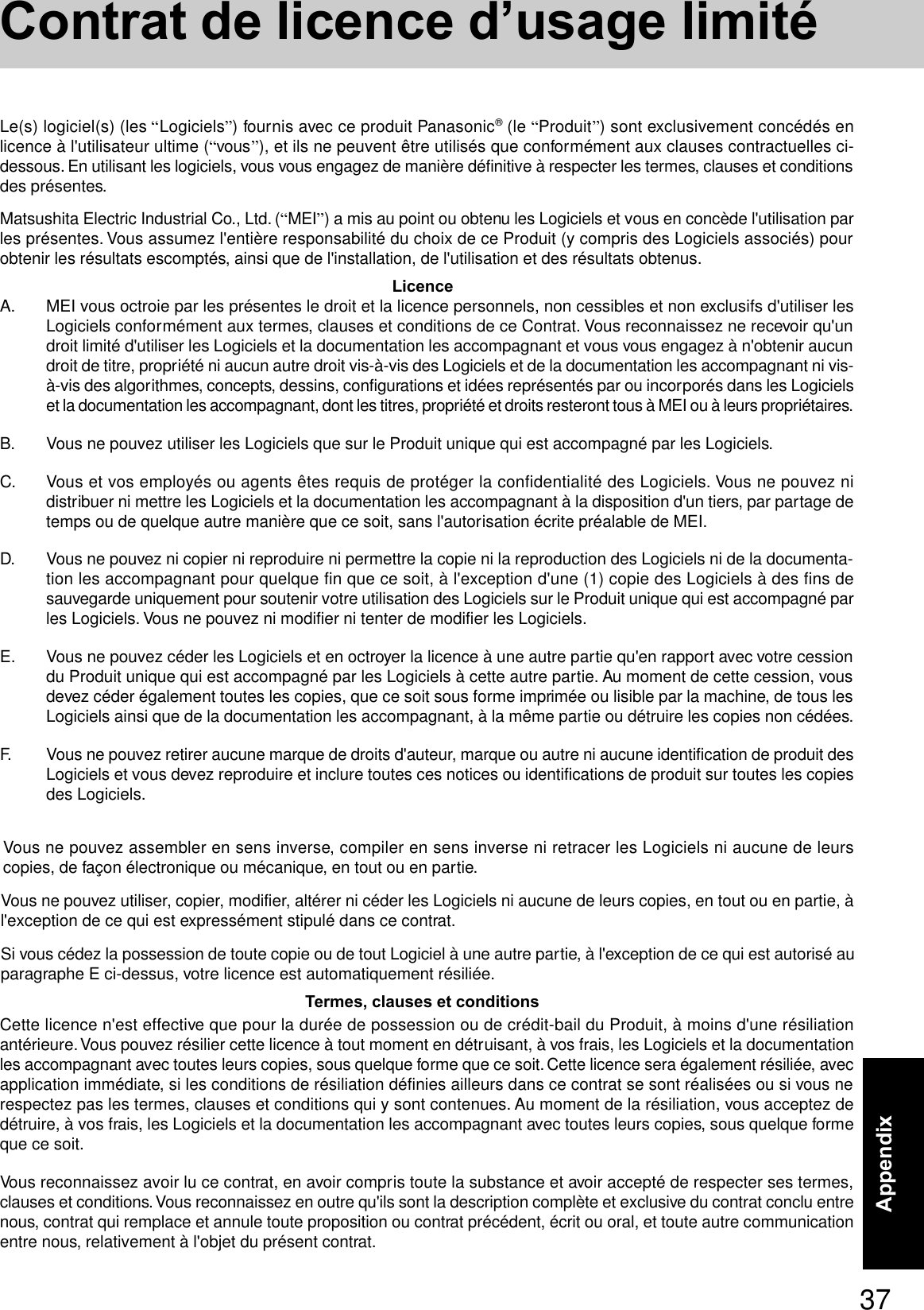
![38AppendixHard Disk Backup FunctionThe hard disk backup function creates a backup area (storage area) on the hard disk. This area is to back up (store) hard diskcontents or restore backed up contents to their original locations.By backing up the data on your hard disk to a backup area, you can protect your data from loss or damage resulting from operationalerrors or other factors. Also, you can back up or restore hard disk contents using this computer alone, without having to use othermedia or peripheral devices.At the time of purchase, the hard disk backup function is disabled. If you follow the procedure below to create a backup area, thehard disk backup function will be enabled, and you will be able to back up your data. Note, that once the backup function has beenenabled, you will have to perform the reinstallation procedure to disable it again ( page 34).Disconnect or remove all peripheral devices (except for the DVD-ROM & CD-R/RW drive), SDmemory cards, and MultiMedia Cards. Take care to disconnect the USB floppy disk drive, as thebackup area may not be created properly while these devices are connected.Be sure the AC adaptor is connected to the computer.A backup area cannot be created if the hard disk is already divided into several partitions. Returnthe computer to its condition at the time of purchase (one partition only), and create the backuparea.To divide the partition, make the selection when the backup area is created ( page 39 step 8).If the partition configuration is changed (partitions created, size changed, etc.) after the backuparea has been created, it will no longer be possible to execute the backup function. To change theconfiguration, it is necessary to return the computer to its condition at the time of purchase, andthen create the backup area again.The hard disk backup function will only work for the internal hard disk. This function does notwork with an external hard disk.Backup and restore functions will not operate if the hard disk has been damaged.Do not use the NTFS file system compression function, as this may result in insufficient capacityof the backup area.If the hard disk malfunctions, it will be impossible to read the data stored on it. We recommendthat you also back up important data to a location other than the hard disk (an external hard diskor other media).Execute a disk error check using the following procedure.1Display [Local Disk (C:) Properties].Right-click [Local Disk(C:)] in [start] - [My Computer], and click [Properties].2Click [Check Now] from [Tools].3In [Check Disk Local Disk (C:)], click [Start] without adding a check mark beside any of theitems.If a message is displayed indicating that there is an error in the disk, display [Check Disk LocalDisk (C:)], and add a check mark for [Automatically fix file system errors] and [Scan for andattempt recovery of bad sectors], click [Start], and check for disk errors again.The hard disk backup function does not accommodate dynamic disks. Do not convert the harddisk to a dynamic disk.The hard disk backup function cannot back up or restore data properly if there is a problem with the hard disk when the data isbacked up or restored. Note that if an error occurs while data is being restored, whether as a result of an unexpected malfunction,incorrect operation, or other reason, the data in the hard disk (data before restoration) may be lost.Matsushita Electric Industrial Co., Ltd. will bear no responsibility for any damages suffered by the user (including loss of data)as a result of the use of this function.Before Using a Hard Disk Backup FunctionPreparingProduct Recovery CD-ROM (included)Panasonic DVD-ROM & CD-R/RW drive (optional: CF-VDRRT1M, CF-VDRRT2W, CF-VDRRT3W)](https://usermanual.wiki/Panasonic-of-North-America/9TGCF-T41.PC-User-Manual/User-Guide-566641-Page-38.png)
![39Appendix1Turn off the computer and connect the DVD-ROM & CD-R/RW drive to the computer.2Turn the computer on, and press F2 while [Panasonic] boot screen is displayed.The Setup Utility will start up.If a password has been set, enter the Supervisor Password.You cannot register [Boot] menu with a User Password.3Select the [Boot] menu, then select [USB CD/DVD Drive] and press F6 until [USB CD/DVDDrive] is at the top of the [Boot] menu.4Place disc number one of the recovery CDs into the DVD-ROM & CD-R/RW drive.5Press F10 .At the confirmation message, select [Yes] and press Enter .The computer will restart. If [Enter Password] is displayed during the following procedures, inputthe Supervisor Password or the User Password.This screen should appear.Regarding backup area• Requires availability of at least half of the entire hard disk. Without sufficient spaceavailable, the backup area cannot be created.• When the backup area is created, the usable hard disk capacity will be reduced to lessthan half.• The backup area cannot be accessed from Windows. For this reason, backed up datacannot be copied to CD-R or other removable disk media.• When the hard disk backup function is executed, data in the backup area will be over-written. If newly created or edited data is backed up later, data stored previouslyin the backup area will be lost.NOTECreate a Backup AreaWhen dividing the hard disk into partitionsDo not execute [1. [Recovery]] to divide the hard disk into partitions. The hard diskbackup function cannot be enabled after the hard disk has been partitioned. Use step 8to divide the hard disk.CAUTION---------------------------------------------------------------------Select a number---------------------------------------------------------------------1. [ Recovery ] Reinstall Windows.2. [ Erase HDD ] Erase the whole data on HDD for security.3. [ Backup ] Enable the Backup function.0. [ Cancel ] Cancel.---------------------------------------------------------------------6Press 3 to execute [3. [Backup]].7At the confirmation message, press Y .The usable hard disk area[At the time of purchase] [After the backup area is created]The backup areaCannot be accessedfrom Windows.Can be accessed fromWindows (One partition).8Select how to divide the hard disk from the menu.<To create a backup area and enable the backup function without dividing the hard disk>Select [1].](https://usermanual.wiki/Panasonic-of-North-America/9TGCF-T41.PC-User-Manual/User-Guide-566641-Page-39.png)
![40AppendixHard Disk Backup FunctionNOTE<To create a backup area and divide hard disk into two partitions, for OS and data>Select [2], enter the partition size (GB), and press Enter .• You can cancel this operation by pressing 0 .• The data partition size will be the maximum settable size less the number entered above.The maximum settable size will differ depending on models.The [Boot] menu in the Setup Utility is set to start up from the DVD-ROM & CD-R/RWdrive. Change this setting if necessary.The next time the backup or restore functions are executed, follow the procedure for [BackingUp and Restoring Data] ( below).NOTEThe usable hard disk area[At the time of purchase] [After the backup area is created]The backup areaCannot be accessedfrom Windows.Do not press Ctrl + Alt + Del until the message is displayed.CAUTIONCan be accessed fromWindows (Two partitions).1Turn the computer on, and press F2 while [Panasonic] boot screen is displayed.The Setup Utility will start up.If a password has been set, enter the Supervisor Password or the User Password.2Select [Exit] menu, then select [Hard Disk Backup / Restore] and press Enter .At the confirmation message, select [Yes], and press Enter .3Select the operation to be executed from the menu.<To back up hard disk contents to the backup area>1Press 1 to execute [1. [Backup]].(When dividing the hard disk into two partitions, select the backup method at next screen.)2At the confirmation message, press Y .The backup process will begin.<To restore backed up contents to the hard disk>1Press 2 to execute [2. [Restore]].(When data is backed up in two partitions, select the restore method at next screen.)2At the confirmation message, press Y .The restore process will begin.Backing Up and Restoring DataBefore executing the backup function, execute a disk error check ( page 38).Do not interrupt the backup or restore functions before completion, for example by turningoff the power or pressing Ctrl + Alt + Del , as this may prevent Windows from startingup, or may cause data to be lost so that the backup and restore functions cannot be executed.CAUTION12 After logging on to Windows, a message will appear advising that a new device has been installedand that the computer must be restarted to enable the settings. Select [Yes] to restart the computer.The time required to complete the backup or restore process differs depending on the data volume.9At the confirmation message, press Y .The backup area is then created.10 When the message [You must reboot in order to enable the Backup function.] appears, removethe recovery CD-ROM, and press any key to restart the computer. The computer is restarted,then the backup process will begin.11 When the message [[Backup] is complete] appears, press Ctrl + Alt + Del to restart the computer.](https://usermanual.wiki/Panasonic-of-North-America/9TGCF-T41.PC-User-Manual/User-Guide-566641-Page-40.png)
![41AppendixTo disable the hard disk backup functionPerform the reinstallation procedure. All data in the backup area and the hard disk will be erased.Conduct steps 1-8 for [Reinstalling Software] ( page 34). Select [1] or [2] to execute thereinstallation at the screen for executing the reinstallation.• When [1] is selected, the hard disk backup function can be disabled.• When [2] is selected, the hard disk backup function can be disabled, but in this case, becausethe hard disk has been divided into partitions, the hard disk backup function cannot be re-enabled ( page 26).• When [3] is selected, the hard disk backup function cannot be disabled.CAUTIONWhen the hard disk backup function has been enabled, the backed up data will not be erasedeven if a commercial data erasing utility or similar software is used to erase all data fromuser-accessible area. You can use the hard disk data erase utility included in this computer( page 42) to erase all data on the hard disk, including backed up data. Use this hard diskdata erase utility before disposing of or transferring ownership of this computer.Occasionally, the message [#1805 cannot write image file] will be displayed, and the backupfunction will be interrupted. If this error occurs, execute the backup function again. Afterthis, if the backup function is completed properly, then there is no problem in the hard disk.4When the message [[Backup] is complete] or [[Restore] is complete] is displayed, press Ctrl + Alt + Del to restart the computer.• If the backup or restore process was interrupted before completion, for example if the powerwas turned off, execute the process again.• When a new device is installed and a message appears advising that the computer must berestarted to enable the settings, select [Yes] to restart the computer.<When the hard disk backup function has been enabled>If you select [3] in step 9 ( page 34) and execute reinstallation, the drive letter for the secondpartition (data partition) may be switched with that of the SD memory card. You can still use thedrives after the letters have been switched, but you can also return the drive letters to their originalstate using the following procedures.(The following procedure assumes that before reinstallation, the second partition (data partition)was Drive D:, and the SD memory card was Drive E:)1Disable the drive letter for the second partition (data partition).1Click [start] - [Control Panel] - [Performance and Maintenance] - [Administrative Tools] anddouble click [Computer Management].2Click [Disk Management] from [Storage].3Right click on the partition for which [E:] is displayed and click [Change Drive Letter andPaths...].4Click [Remove].5At the confirmation message, click [Yes].2Change the SD memory card drive letter to [E:].Use the SD drive letter change tool to change the SD memory card to the E: drive. ( “SD Memory Card/ MultiMedia Card”)3Set the drive letter for the second partition (data partition) as [D:].1Click [start] - [Control Panel] - [Performance and Maintenance] - [Administrative Tools] anddouble click [Computer Management].2Click [Disk Management] from [Storage].3Right click on the partition for which the drive letter is not displayed, and click [ChangeDrive Letter and Paths...].4Click [Add...], assign [D:] as the drive letter, and click [OK].](https://usermanual.wiki/Panasonic-of-North-America/9TGCF-T41.PC-User-Manual/User-Guide-566641-Page-41.png)
![42AppendixHard Disk Data Erase UtilityThis computer is equipped with a utility for erasing hard disk data.When disposing of or transferring ownership of this device, erase all data on the hard disk in order to prevent the theft of hard diskdata by following the steps below.The hard disk data erase utility erases data using an overwriting method, but there is a possibility that due to malfunctions orother operational errors, data may not be completely erased. There are also specialized devices that may be able to read data thathas been erased using this method. If you need to erase highly confidential data, we recommend that you contact a company thatspecializes in this process. Matsushita Electric Industrial Co., Ltd. will bear no responsibility for losses or damages suffered asa result of the use of this utility.Preparing• Product Recovery CD-ROM (included)• Panasonic DVD-ROM & CD-R/RW drive (optional: CF-VDRRT1M, CF-VDRRT2W, CF-VDRRT3W)ProcedureNOTEBe sure the AC adaptor is connected until the procedure is completed.This utility can only be used for internal hard disk. It cannot be used to erase data from external hard disks.This utility cannot erase data from damaged disk.This utility cannot erase data for specific partitions.After executing this utility, the computer cannot be booted from the hard disk.The backup area and the data in the backup area will be erased.1Turn off the computer.2Connect the DVD-ROM & CD-R/RW drive to the computer.3Turn the computer on, and press F2 while [Panasonic]boot screen is displayed.The Setup Utility will start up.If the password has been set, enter the Supervisor Password.4Select the [Boot] menu, then select [USB CD/DVD Drive]and press F6 until [USB CD/DVD Drive] is at the top ofthe [Boot] menu.5Place the disc number one of the recovery CDs into theDVD-ROM & CD-R/RW drive.6Press F10 .At the confirmation message, select [Yes] and press Enter .The computer will restart, and this screen should appear.---------------------------------------------------------------------Select a number---------------------------------------------------------------------1. [ Recovery ] Reinstall Windows.2. [ Erase HDD ] Erase the whole data on HDD for security.3. [ Backup ] Enable the Backup function.0. [ Cancel ] Cancel.---------------------------------------------------------------------<When the hard disk backup function has been enabled>When the message [The Backup function has been enabled.If [Recovery] or [Erase HDD] is executed, the Backup func-tion will be disabled, and your Backup data will be lost.]appears, press Y .7Press 2 to execute [2. [Erase HDD]].(You can cancel this operation by pressing 0 .)<When the hard disk backup function has been enabled>When the message [The Backup function has been enabled.If [Erase HDD] is executed, the Backup function will bedisabled, and your Backup data will be lost.] appears, press Y .When the message [Computer must be rebooted in order toexecute [Erase HDD.]] appears, press R .8At the confirmation message, press Y .9When [<<<Start menu>>>] is displayed, press Enter .10 The approximate time required for erasing data will be dis-played.Press Space .11 At the confirmation message, press Enter . The operationof erasing the hard disk will start.(If necessary, the “hard disk data erase” operation can becancelled after it has begun by pressing Ctrl + C .If the operation is cancelled before being completed, a partof data will not be erased.)12 After the operation is complete:Under normal conditions, the message [Hard disk data hasbeen deleted.] will be displayed.If a problem occurred during the operation, an error mes-sage will be displayed.13 Remove the recovery CD, and then press any key to turn offthe computer.14 Remove the DVD-ROM & CD-R/RW drive.](https://usermanual.wiki/Panasonic-of-North-America/9TGCF-T41.PC-User-Manual/User-Guide-566641-Page-42.png)
